Caroline Leavitt's Blog, page 18
July 29, 2018
Jennifer Gilmore talks about her incandescent novel IF ONLY, adoption, possiblity and so much more.
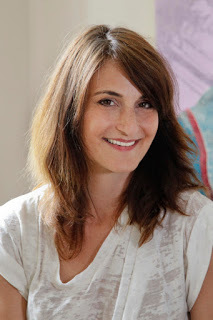
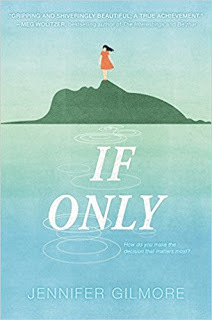
I can't remember when I first met Jennifer Gilmore, but what's really important is I cannot remember a time when I DID NOT LOVE HER. Her novels are fantastic, critically acclaimed and deeply loved. She was kind enough to interview me at McNally Jackson when I was a nervous wreck, kind enough to turn around in her assigned seat at the Jewish Book Council Auditions to shoot the breeze with me when I was a nervous wreck. I'm not a nervous wreck anymore!
Jennifer is the author of three novels for adults, and a novel for teens-We Were Never Here and for adults, The Mothers, (Scribner 2013), currently being adapted to film,which she is Executive Producing, Something Red, (Scribner 2010), a New York Times Notable Book, and my first novel, Golden Country (Scribner 2006), a New York Times Notable Book of 2006, an Amazon Top Ten Debut Fiction of 2006, a finalist for the National Jewish Book Award, on the long-list for the International IMPAC Dublin Prize, a finalist for the Harold U Ribalow Prize, and a finalist for the Los Angeles Times Book Prize.
And course, her latest IF ONLY is about the possibilities in a young girl's life.
Thank you so much, Jennifer, for this book, and for EVERYTHING.
I always think there is a why now moment for an author to write any book. What were the origins of this one for you?
If Only, which on the surface is a book about adoption, but is also about all the ways we imagine what our lives could be and could have been, has this premise that our lives are not necessarily destined. That one small thing could have changed our course. (The science behind the Butterfly Effect, in chaos theory, deals with this idea, too.) I have an adopted child and I hate to think that we weren’t as destined to be together as biological children and their mothers are, but it nagged at me. The what if’s. What if my child’s birthmom hadn’t chosen us. I could go down a spiral and become undone by the thought. And then, as a novelist, and a novelist who writes about teens, I wondered: what made her make the decisions she did. How did she go about it? That’s when my imagination kicked in. I wanted to include her many possibilities, as well as her biological daughter’s many possibilities, which I call the If Onlys. I wanted to connect them. But I couldn’t have written this book when I first came home with my son. My thinking had to be more processed and less emotional. I think when you’re really writing you look in the face a lot of the stuff that makes you uncomfortable or scared. That’s the sweet spot for the writer.
You’ve written extraordinary books for adults and this is your second for YA. How does it feel different? Does it free you in some way?
As you know, all books are hard to write. Just so hard! Young adult feels different only in that my characters are teenagers. I am getting in touch with the 15 year old in me all the time. (To be honest, she’s always with me anyway.) We are, after all, the ages we ever were at the same time. In some ways the form is more constricting: it tends to be first person with forward motion and often plot can be a stand in for emotion. But that is very generalized. In other ways—in this case structurally—it was freeing as I think teen readers go with what you offer more readily. They make a leap of faith without having to be technically lead there. They are open and willing and I love that about my teen readers. And it’s exciting (without over generalizing again) teens care about books—remember what you read as a teen? The music you listened to? Exactly. It’s imprinted upon us.
You’ve written so gorgeously about your becoming a mother, adopting, and the whole process, and it infuses this wonderful book in such unexpected ways. Would you mind talking about this?
I love talking about being an adoptive mother because I’m proud to be one and lucky to be one. There is a lot of language surrounding adoption—in the adoption community, from one’s biological family, from friends, and from people you just meet on the street. It’s shocking to me what people say, like: Your son is so lucky! Or: we know people who have adopted and they love their kids just as much as we love ours. That’s not the half of it. And my child is white—being the adoptive mother of a transracial child presents new kinds of conversations that people think they can have with you. It’s shocking to me. What I mean to say is, like in everything we are experiencing in this world right now, language matters. How we talk about what is important to us and difficult matters. How we dismiss peoples’ experiences or think we are in a position to validate them matters. The language is the beginning. That is the power I feel I have as a fiction writer who writes about adoption. I can take on these false notions or these complicated socio economic issues and make art out of this troubling and often culturally airbrushed conversation.
What’s obsessing you now and why?
What’s obsessing me…How hard it is to find a way into something important that is still what you would want to read. How to create in the face of a truly demoralizing state. How to think about characters and still be in the world. I’m very interested in transformation. All the ways in which that happens for us, for women in particular. What were you before? Where did you go?
What question didn’t I ask that I should have?
You covered it! As always. Thank you for being such a wonderful supporter of my work and all our work. And happy art making to you, too.
<!-- /* Font Definitions */ @font-face {font-family:Times; panose-1:2 0 5 0 0 0 0 0 0 0; mso-font-alt:Times; mso-font-charset:0; mso-generic-font-family:auto; mso-font-pitch:variable; mso-font-signature:3 0 0 0 1 0;} @font-face {font-family:"MS 明朝"; mso-font-charset:78; mso-generic-font-family:auto; mso-font-pitch:variable; mso-font-signature:-536870145 1791491579 18 0 131231 0;} @font-face {font-family:"Cambria Math"; panose-1:2 4 5 3 5 4 6 3 2 4; mso-font-charset:0; mso-generic-font-family:auto; mso-font-pitch:variable; mso-font-signature:-536870145 1107305727 0 0 415 0;} @font-face {font-family:Cambria; panose-1:2 4 5 3 5 4 6 3 2 4; mso-font-charset:0; mso-generic-font-family:auto; mso-font-pitch:variable; mso-font-signature:-536870145 1073743103 0 0 415 0;} /* Style Definitions */ p.MsoNormal, li.MsoNormal, div.MsoNormal {mso-style-unhide:no; mso-style-qformat:yes; mso-style-parent:""; margin:0in; margin-bottom:.0001pt; mso-pagination:widow-orphan; font-size:12.0pt; font-family:Cambria; mso-ascii-font-family:Cambria; mso-ascii-theme-font:minor-latin; mso-fareast-font-family:"MS 明朝"; mso-fareast-theme-font:minor-fareast; mso-hansi-font-family:Cambria; mso-hansi-theme-font:minor-latin; mso-bidi-font-family:"Times New Roman"; mso-bidi-theme-font:minor-bidi;} .MsoChpDefault {mso-style-type:export-only; mso-default-props:yes; font-family:Cambria; mso-ascii-font-family:Cambria; mso-ascii-theme-font:minor-latin; mso-fareast-font-family:"MS 明朝"; mso-fareast-theme-font:minor-fareast; mso-hansi-font-family:Cambria; mso-hansi-theme-font:minor-latin; mso-bidi-font-family:"Times New Roman"; mso-bidi-theme-font:minor-bidi;} @page WordSection1 {size:8.5in 11.0in; margin:1.0in 1.25in 1.0in 1.25in; mso-header-margin:.5in; mso-footer-margin:.5in; mso-paper-source:0;} div.WordSection1 {page:WordSection1;} </style><span style="font-family: Times, "Times New Roman", serif;"><span style="font-size: small;"> </span></span>
Published on July 29, 2018 10:44
Babies in incubators were the brainchild of a mysterious immigrant "doctor"--and a sideshow attraction! Dawn Raffel talks about THE STRANGE CASE OF DR. COUNEY
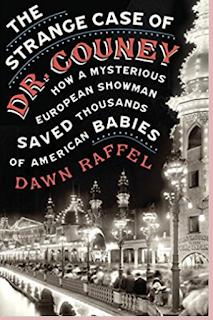
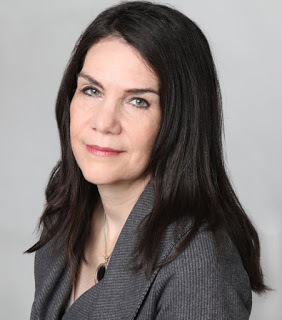
Oh my God, You need to read this fascinating book. The Strange Case of Dr. Couney is the extraordinary tale of how a mysterious immigrant "doctor" became the revolutionary innovator of saving premature babies--by placing them in incubators in World's Fair side shows and on Coney Island and Atlantic City.
Dawn Raffel's illustrated memoir, The Secret Life of Objects, was a Wall Street Journal bestseller. Previous books include a critically acclaimed novel, Carrying the Body, and two story collections— Further Adventures in the Restless Universe and In the Year of Long Division.
Her writing has been published in O, The Oprah Magazine, BOMB, New Philosopher, The San Francisco Chronicle, Conjunctions, Black Book, Open City, The Anchor Book of New American Short Stories, Arts & Letters, The Quarterly, NOON, and numerous other periodicals and anthologies—most recently The Best Short Fictions 2016 (selected by Stuart Dybek) and The Best Short Fictions 2015 (selected by Robert Olen Butler).
She was a fiction editor for many years, helped launch O, The Oprah Magazine, where she served as Executive Articles Editor for seven years, and subsequently held senior-level "at- large" positions at More magazine and Reader's Digest. In addition, she served as the Center for Fiction's web editor. She has taught in the MFA program at Columbia University, the Center for Fiction, and at Summer Literary Seminars in St. Petersburg, Russia; Montreal; and Vilnius, Lithuania.
She currently works as an independent editor for individuals and creative organizations, specializing in memoir, short stories, and narrative nonfiction. She is also a certified yoga instructor and teaches embodied creative writing.
AND most importantly, Dawn lives down the block from me! Our kids went to school together. AND I will be interviewing Dawn at Hoboken's Little City Books in September 27, so check your schedule and COME.
Thank you, Dawn.
I was totally fascinated by your novelbook, which tells the story really of incubators in World’s Fair side shows—and the doctor who began the practice. My jaw dropped open. Where did you come across this incredible story and why did you feel that you just had to write it?
Initially, I planned to write a novel set at the Chicago World’s Fair in 1933. In doing the research I discovered that the big hit of the fair was a display of live premature infants in incubators—not in the Hall of Science, but out on the midway, right next door to the infamous stripper Sally Rand! Then I learned that the doctor in charge of the incubators wasn’t just doing a one-time show; he had a home base on Coney Island for more than 40 years. That did it for me. I realized that I needed to tell this story, and I needed to tell it as nonfiction. I could not understand how something like this could go one for decades. Was Martin Couney exploiting children or saving their lives? Who would send their baby to a sideshow? Why were there so few incubators in hospitals? To be honest, I had no idea what I was getting myself into in terms of research—as in, hello, 600 end notes.
What surprised you in your research? What particular things changed the plot for you?
There were two big surprises. Martin Couney was famous during his lifetime, and every published account of him—in newspapers and magazines—cited his stellar European medical credentials. More recently, he’d been discussed in peer reviewed medical publications, but always with that same bio. It took quite a while to determine that those often-repeated credentials were a very carefully constructed fabrication. Martin Couney’s story was so well-made that without the Internet anda whole lot of shoe leather, his cover would have never been blown. The fact that he was not a real doctor actually made me more sympathetic to him. If he had really been a physician, with degrees from august institutions and an internship with a world-renowned French doctor, as he claimed, then spending the rest of his life running a sideshow rather than trying to work within the system could be seen as self-serving. The truth is, he had no other recourse—he couldn’t practice in a hospital or publish clinical papers. He could only save these children one at a time, and try to persuade the medical establishment to follow suit.
The other, darker surprise was the chilling effect of the American eugenics movement. Although eugenics never directly targeted preemies, they were called “weaklings” in the medical literature, and in an environment that promoted survival of the fittest and propagation of the “superior,” these tiny lives weren’t valued.
Dr. Couney is one of the most fascinating people I’ve encountered. While he genuinely cared for his tiny charges, he also made them sideshow attractions. Where do you think was the greater pull?
Martin Couney loved life. He cared about saving lives, and he also delighted in living a very good life himself; he certainly enjoyed making money with a very popular show, and he loved talking to people, with a showman’s flair. Frankly, he was right that the public was not going to pay attention to the plight of preemies unless he entertained them. I don’t think he saw a conflict between saving lives and growing rich, and if he could do an end-run around the IRS, so much the better. In the end, I’d have to say he cared most about saving lives. He never cut corners in the babies’ care, even when he was going broke toward the end of his life. He could have quit and cut his losses; and he also could have cut expenses on things like nursing and nutrition. He did neither. As long as there was a child he could save, he did whatever he had the means to do.
This marvelous book seems different to me than your last incredible books. Did it feel different writing it? And if so, how so?
I think with every book, you have to learn how to write it. This book was indeed very different, because my previous books were fiction (and one memoir). With fiction I will often let the language and the composition lead me into new and surprising places, whereas here I had to stick faithfully to the facts. I felt a responsibility to Martin Couney himself to get this story right, and to all of the people I interviewed, including several of his former patients. I went though four full drafts, plus a fifth one where I re-fact checked everything.
What’s obsessing you now and why?
You mean aside from getting this book out into the world? While writing it, I also became certified as a Bhakti yoga instructor. I’ve always been kind of a poster child for klutziness. But I’ve been teaching creative writing for a long time, and I’ve been looking for a way to help writers develop a more embodied, emotionally sustainable approach to their work. I’m in the process of creating that program. It’s far less about physical flexibility than it is about mental flexibility, stamina, and precision.
What question didn’t I ask that I should have?
You asked great questions! If I may, I will add a note of gratitude to librarians and archivists everywhere, for being the guardians of our history. We tend to think that all information can be found on Google. But while Google is a godsend for research, it’s only a starting point—there is a world of knowledge that is not digitized, and that is carefully maintained by people who are rarely recognized, but who deserve our gratitude and financial support.<!-- /* Font Definitions */ @font-face {font-family:"MS 明朝"; mso-font-charset:78; mso-generic-font-family:auto; mso-font-pitch:variable; mso-font-signature:-536870145 1791491579 18 0 131231 0;} @font-face {font-family:"Cambria Math"; panose-1:2 4 5 3 5 4 6 3 2 4; mso-font-charset:0; mso-generic-font-family:auto; mso-font-pitch:variable; mso-font-signature:-536870145 1107305727 0 0 415 0;} @font-face {font-family:Cambria; panose-1:2 4 5 3 5 4 6 3 2 4; mso-font-charset:0; mso-generic-font-family:auto; mso-font-pitch:variable; mso-font-signature:-536870145 1073743103 0 0 415 0;} /* Style Definitions */ p.MsoNormal, li.MsoNormal, div.MsoNormal {mso-style-unhide:no; mso-style-qformat:yes; mso-style-parent:""; margin:0in; margin-bottom:.0001pt; mso-pagination:widow-orphan; font-size:12.0pt; font-family:Cambria; mso-fareast-font-family:"MS 明朝"; mso-bidi-font-family:"Times New Roman";} span.msoIns {mso-style-type:export-only; mso-style-name:""; text-decoration:underline; text-underline:single; color:maroon;} span.msoDel {mso-style-type:export-only; mso-style-name:""; text-decoration:line-through; color:maroon;} .MsoChpDefault {mso-style-type:export-only; mso-default-props:yes; font-size:10.0pt; mso-ansi-font-size:10.0pt; mso-bidi-font-size:10.0pt; font-family:Cambria; mso-ascii-font-family:Cambria; mso-fareast-font-family:"MS 明朝"; mso-hansi-font-family:Cambria;} @page WordSection1 {size:8.5in 11.0in; margin:1.0in 1.25in 1.0in 1.25in; mso-header-margin:.5in; mso-footer-margin:.5in; mso-paper-source:0;} div.WordSection1 {page:WordSection1;} </style>
Published on July 29, 2018 10:34
T. Greenwood talks about her incandescent RUST & STARDUST, based on the real-life kidnapping that inspired Nabokov's Lolita. You KNOW you want to read this.
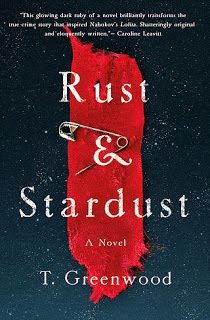
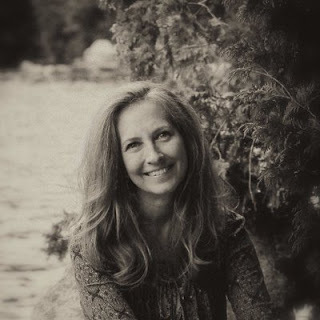
T. Greenwood is amazing. A super talented photographer, she has also published twelve novels, including BODIES OF WATER (a finalist for a Lambda Foundation Award). She has received grants from the Sherwood Anderson Foundation, the Christopher Isherwood Foundation, the National Endowment for the Arts, and the Maryland State Arts Council. And if that's not enough, she's won three San Diego Book Awards.?
Rust & Stardust, the gripping, heart-wrenching novel of Sally Horner, the 11-year-old kidnapping victim whose abduction in 1948 inspired Nabokov's Lolita is already racking up the raves. Wanna see?
"Unflinching but compassionate, Greenwood deftly unravels the devastating layers of malice and carelessness that tore Sally from her family, but also the love and perseverance that eventually brought her home."—Bryn Greenwood, author of the New York Times bestseller All the Ugly and Wonderful Things
"A harrowing, ripped-from-the-headlines story of lives altered in the blink of an eye, once again proving her eloquence and dexterity as an author.”—Mary Kubica, New York Times bestselling author of The Good Girl
"An absolute treasure for bookclubs and the discussions it is sure to inspire."—Pamela Klinger-Horn, Excelsior Bay Books
Thank you so much for being here!
I was absolutely haunted by this story. When was the moment when you realized, I have to write this story?”
I read Lolita in college and swooned. The idea that someone could write about something so horrifying in such achingly beautiful language felt like a sort of magic. That was the kind of writer I wanted to be.
Sally Horner was in those pages, though I didn’t know it at the time, sequestered in a tiny parenthetical: (Had I done to Dolly, perhaps, what Frank Lasalle, a fifty-year-old mechanic, had done to eleven-year-old Sally Horner in 1948?) Flash forward twenty plus years, and I stumbled upon an essay by Sarah Weinman (“The Real Lolita” in Hazlitt) which reveals the likelihood that Nabokov borrowed from Sally Horner’s story in crafting the second half of Lolita. (Nabokov was known to scour newspapers for crimes that echoed Humbert Humbert’s.) But what spoke to me more than all of this was the photo accompanying the essay – the one of a golden sort of child sitting on a swing. Eleven years old, abducted by a life-long criminal. She’d only been trying to join a girl’s club at school – the initiation involving the theft of a five-cent notebook from a Woolworth’s. LaSalle, recently released from prison, “caught her” and was able to convince her that he was with the FBI, that if she didn’t do as he said, he would have her arrested. At the time, my youngest daughter was eleven years old – and while likely much savvier than Sally would have been in 1948, I couldn’t help but imagine her in a similar circumstance. That longing to belong to a group of girls so palpable, the blind abeyance to authorities, the cusp at which girls at that age reside. I fell in love with Sally first.
Then, when I began to research this true crime, it felt as if it was a story I had been meant to write my whole life. From the places LaSalle took her, to the people she would have likely encountered, there were so many connections to my own experience, it felt like serendipity.
What was your research like? Can you tell us any things you changed or added for the sake of fiction?
I spent about six months reading everything I could get my hands on about Sally and Frank LaSalle. I scoured newspapers.com, ancestry.com, and a whole host of other sites trying to glean everything I could about the twenty-one months she was in his custody. I also studied the various places he took her and researched the historical context.
Ultimately, however, this is fiction. I had the skeletal structure of the plot – the actual events and locations and timeline, but the flesh is pure imagination. I had to dream myself into Sally’s character, her mother’s character, those girls who set her on this tragic path. I also created a number of fictitious characters (mostly women who unwittingly aided in Sally’s survival).
While I made every effort to honor the “facts” I knew to be true, I also took a thousand liberties (which is what fiction writers do) in an effort to bring this story and these characters (as I dreamed them) to life.
I absolutely loved that you told this story through the eyes of various characters—Sally’s mother, her sister, Ruth. Was this always your decision as far as craft? I also absolutely loved the kind bearded lady—where did she come from?
The first draft of this novel was written from an omniscient and someone distanced point of view. I wanted it to be the story of not only Sally but also of those around her, those impacted by this crime. However, with each subsequent draft (and there were many), I zoomed in closer and closer to the primary point of view characters. I actually wrote about fifty pages from Frank’s point of view, but in a very late draft decided to excise him. Nabokov had already written that story. I wanted this to be Sally’s story, the story of her family, and the story of the communities she inhabited.
As for Lena (the bearded lady), she was a total surprise but ultimately became one of my favorite characters. In researching the trailer court where Frank and Sally lived in Dallas, TX, I learned that when the circus was in town, the circus folks often stayed there. This was one of those amazing gifts a writer gets, because all of a sudden, Lena materialized on the page…this gorgeous, leggy hermaphrodite, who sees herself in Sally.
Reading this novel made me completely unsettled, which is my highest compliment, by the way. What was it like writing it?
As I said, the early drafts were written from a sort of dissociated point of view. I was, frankly, scared to write this story, to be inside Sally’s skin. It probably took four drafts before I even wrote her point of view in. I knew that spending time with her, inhabiting her body, would mean engaging in her suffering. I also knew that finding the balance between raw honesty and delicacy was critical. I didn’t want this to be a lurid exploitation but a reverent exploration of what she must have gone through.
Nabokov ends Lolita in a different way than the way the true crime story here ended. Why do you think he did that?
I recently read an essay about possible connections between Lolita and a story Salvador Dali wrote. In the essay, Nabokov is said to have referred to gathering “bits of straw and fluff” for his novels. I think that Sally really was one of those bits of straw for him. His parenthetical about her suggests as much. But Sally’s story is not, in the end, Lolita’s story.
What’s obsessing you now and why?
Here are my current twigs and fluff: a state “school” in western Massachussetts called The Belchertown School for the Feeble-Minded, 1970’s Florida, Weeki Wachee mermaids, the opening of Walt Disney World in 1971.
I have wanted to write a story set in the early 1970s Florida forever. My family used to drive to Florida from Vermont every winter (in a VW Bug no less). I love writing about lost places. I am also totally captivated by abandoned asylums.
What question didn’t I ask that I should have?
This is my twelfth novel, and people are often curious about my process. One of the questions I am most often asked is if I write every day or only when inspiration hits, and my answer is that I write regardless of inspiration. If I waited for inspiration to hit, I’d never get anything done.
Published on July 29, 2018 10:26
July 18, 2018
This is My Abortion Story. No, It Isn't. Yes, It is.
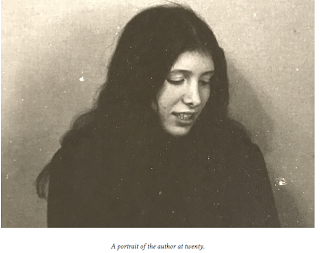 I never put my essays up on my blog, but I am feeling crushed by our country right now, and I feel it’s important for us to share our stories, to say me, too. So here is mine from The Manifest-Station, with thanks to the amazing women who run it, Jennifer Pastiloff and Angela M. Giles.
I never put my essays up on my blog, but I am feeling crushed by our country right now, and I feel it’s important for us to share our stories, to say me, too. So here is mine from The Manifest-Station, with thanks to the amazing women who run it, Jennifer Pastiloff and Angela M. Giles.This is my Abortion Story. No, It Isn't. Yes, It Is
By Caroline Leavitt
Let’s start in the 1970s in Boston, where abortion is so illegal, it’s spoken of only in an appalled whisper. You’ve seen the photos, right? Young, naked women, crumpled like puppets, bleeding out on a floor, from coat hangers, from poisons, from desperation. Dead girls. Ruined girls. Only wealthy girls can get safe abortions if they fly somewhere, or know a doctor. And none of us is wealthy. I’m 17, and my older sister is my best friend, my heroine, the person I most want to be. My sister has a charmed life. She’s in college and loves it. She’s so beautiful; photographers stop her on the street to ask to take her photo. Her whole life shines before her like a star she could wish upon. She’s going to get her degree, just one credit left, then she will work, and travel and live by the ocean and be a writer, something she’s already amazingly talented at. And, best of all, like always, she promises to take me with her when she does.
But suddenly, my sister begins locking herself in her room, sobbing, not even coming out for dinner. “She’s got a stomach ache,” my mother tells me. When I know on my sister’s door, she doesn’t answer. One day, I just open the door, and there she is, curled into a comma on her bed, sobbing. ”What’s wrong?” I keep asking, but she just cries harder, and when I ask my mother, she shakes her head and says sharply, “It’s not your business.”
But I love my sister and that makes it my business. She’s always taken care of me, made sure I was okay after a dance when the boy I liked danced with my best friend, given me her coolest, hippest clothes when she’s done with them, and even taken me to the local clubs that would never let me in otherwise. “Let me help,” I beg her and she turns over so her back is to me. “What could possibly be so terrible?” I ask, “What is it? Tell me so I can help,” I beg her, and then she turns around and sits up and I see the misery mapped in her face. “I’m pregnant,” she says.
I sink down on the bed. I know she has a boyfriend, but I don’t much like him because he’s condescending, telling her how she looks better in tailored clothes than the hip Indian prints she prefers, giving her a list of books he thinks she ought to know, even though she reads all the time and doesn’t seem to much like the titles he gives her. But my parents like him, especially my mother, who keeps telling my sister that if she “plays her cards right,” she could be married and settled by next year. She could be taken care of. “She can take care of herself,” I say, but my mother ignores me. “A woman needs a man,” she says.
I don’t think that’s true, but even if it was, where is he? Since my sister’s begun crying, he hasn’t been by our house or even called her. Shouldn’t he be with her now? I know enough not to ask her that question, to make her sadder. Instead, I ask “What are you going to do?” and she swipes at her eyes. “I can’t have a baby now,” she says.
But my mother, and Deb, my sister’s boyfriends mother know what to do. They take over. Deb lives in Baltimore, where abortion, under certain circumstances, is legal. “I know people,” she tells my mom. The two of them plan it all out, while I creep into the far bedroom and listen in on the extension, holding my breath so they won’t know I’m there. And then finally, my sister gets on the line and I hear the plan and it all makes me want to scream, though my sister is so silent that my mom has to say, “Are you still there? Are you hearing all this?”
My sister will have to prove that she’s abandoned by the father and by her own family. She will have to say that she has no recourse, that she is becoming psychotic and will kill herself if she cannot get rid of this baby she doesn’t want. She should scrape a razor across her wrists, not the right way, the vertical way that can kill you, but horizontal, just enough so it will look like she means business. Maybe she could even say she has no idea who the father is. I listen to them talking, practicing and when my mother hangs up, and then my sister, I quickly move to my room, bumping into my mother.
“I know what’s going on,” I say and my mom stiffens. “I heard,” I say.
“They only had sex once, you know,” my mother blurts, and I blink at her astonished that that is the one thing she chooses to tell me now. At 17, I actually know about lust because I’ve been lying all summer about working at a day camp, and instead hightailing it to my boyfriend’s empty house so we can have sex all day long, using the condoms he steals from his older brother. “When is she having the abortion?” I ask and my mother’s mouth becomes a line.
“It’s not an abortion,” she snaps. “Don’t call it that. It’s a D & C.” She enunciates the letters carefully, as if she wants me to memorize them.
Everything changes then. My parents don’t talk about it. My sister won’t talk about it, no matter how much I plead and when I ask what I can do, she says, “You can leave me the fuck alone.”
I don’t get to go to Baltimore with my parents and my sister, though I desperately want to. When she and my parents come home, everyone is silent and angry, and my sister goes back to her bed and I go into her room to get whatever story she’s willing to tell me.
It’s a horror story. Her boyfriend had stayed in Boston, living his life, finishing college in the city, working at a Deb and my parents stay in a hotel, she goes all by herself to a doctor’s office in a strange town she doesn’t know all by herself. She has to talk about how alone she is, how she has no money, how she is hearing voices, even now, because of the stress, but she isn’t sure the doctor believes her. She shows him her wrists, which she scraped with a razor that morning so it might look as if she tried to kill herself, but the doctor looks mildly at her wrists and says that looks superficial. “So I smashed my head against the wall,” she tells me. “Then he said yes to me.”
Alone and young and terrified, she’s let into the hospital, the girl who has no one and nothing, they think, though my parents and Deb are just a half hour away, busy plotting her future. She’s put under and gets the D & C, which of course, is really an abortion. She wakes up and the first thing she does is put her hands on her belly. A handsome young doctor comes in and sits beside her all night, talking, then flirting, and half of her hopes he will ask her out and whisk her away to another country with him, and the other half is so shamed, she wishes for a blindfold. He leaves and then a nurse briskly comes in and tells my sister that some day, maybe a year later, maybe sooner, my sister will think of this day and wonder what her baby would have been like, and that is when my sister screams and screams and screams.
My sister goes back to her old life, but not really. It still has to be a secret, a “tell no one” moment, and she’s changed, as if her skin has hardened into a shell. She doesn’t want to walk to Belmont and take a subway to shop in the city with me. Movies with me are out of the question. “You can go back to your old life,” I tell her. I hope she’s going to break up with her boyfriend. “It’s nothing to be ashamed of,” I tell her. “It was the right choice.”
But she looks miserable, and my parents act as though my sister still has to somehow pay, as if the abortion isn’t a necessary freedom; instead, it’s a kind of punishment for having sex, for wanting to have it. “You’ve had your fun,” my mother tells her.
“Get birth control,” I advise and my mother repeats that my sister and her boyfriend only had sex once. “You don’t plan on it!” she says, as if it is something terrible. For my sister, it is. She drops out of school. My parents push her to marry this boyfriend. “But why?” I say. “She doesn’t have to! There’s no baby!”
My sister is so different. Something was lost here. Not just a pregnancy, but something deeper in my sister. She marries the boyfriend I don’t like and I cry at her wedding because I keep thinking: you don’t have to do this. You have a choice. But, she seems happier now. She’s moving forward. The next day, I go to a doctor and get fitted for an IUD.
Then, it’s twenty-some years later. Hurray! Abortion is legal. Birth control is plentiful and everyone I know is on it because we all happily want to have sex with whomever we please, when we please, and we all want to decide if or when we want to have kids. Still no birth control is 100% and a few of my friends get pregnant, and because they are alone, or they have no money, or any number of reasons, they have abortions. Safe, clean abortions from private doctors. From Planned Parenthood. No one dies. Lives resume for them.
Still, It’s never easy. I watch relationships break up because the woman is too broken afterwards to sustain a relationship. Because the father feels guilty or changed his mind, or maybe because he realizes that it is not his decision to make at all, it’s hers.
So what about me, how do I fit into this? What’s my abortion or not abortion story?
I’m happily married, pregnant with our first child. We have a home and jobs we love and enough money, we hope. I sing to the baby. I keep my hands on my belly and I eat only fruits, vegetables and grains. (Giving up chocolate is hard.) I sail past the third month when everything is supposed to be fine, and I tell everyone, even strangers. One woman at the job where I am working, who knows I am pro-abortion, says quietly, “Bet you think different about abortion now, don’t you? Bet you felt that baby was a person the second you knew you were pregnant, didn’t you?”
I stare at her and then I tell her that I think that women really give birth twice, the first time you claim the baby inside of you—if you ever claim it and want it,–and when it arrives.
“Rightttt,” she says in disbelief.
I’m four months pregnant, just before the amnio, getting a sonogram, when my doctor goes quiet. “What’s wrong?” I ask and that’s when I see the flat line.
Of course I fall apart. This baby was wanted. Needed, maybe my last chance because I am older, a high-risk mom. My doctor is kind. He tells me I can deliver if I want, (a dead birth!) but he suggests that I don’t. Instead, he wants to give me a kind of D and C, put me under as if I am dreaming, and when I hear that word, I think of my sister and her abortion that my mother would only call a D& C, the soak of shame in our household. It’s still a choice for me, and this time it isn’t about sex at all.. I can deliver a dead fetus induced, or I can have a D & C. I chose the D & C.
They do the operation the next day, and for two weeks afterwards, I cannot get out of bed. I cannot eat. Jeff sits besides me holding my hand, telling me it is going to be all right. I’ve never felt a loss like this, a wound that keeps opening.
And then we get the autopsy results. My baby had so many problems that even if it had managed to live and be born, it wouldn’t have survived more than two months. The baby had faulty lungs, a badly damaged heart, and Down syndrome. Jeff and I curl up on the bed and hold each other. If the baby had lived, if we had known about the damage, would we have opted for abortion? How could we have gotten rid of the baby? But how could we have not? The baby would have suffered. The baby would not have lived. We would have depleted all our savings in medical care. I think about choice, how impossibly difficult it would have been to decide, how impossibly difficult to say yes to all that misery, how impossibly difficult to say no, too. But it would have been a choice. My choice.
Years pass. I have a son (!) Roe vs. Wade is on the chopping block, already bleeding. I can’t help but think that this time, abortion isn’t about sex or controlling our own body. This time it’s about fear of women because they hold power, because they can make choices now. But out lives are not a story that men—or any one else but us—should get to tell.
So here is mine.
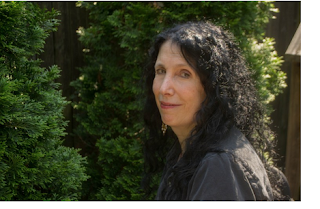
Caroline Leavitt is the New York Times Bestselling author of Pictures of You, Is This Tomorrow, Cruel Beautiful World and an as yet untitled novel, which should be out around 2019 if she is lucky. She is a book critic for People, The San Francisco Chronicle, and the Boston Globe and she finally got a film agent and has written a pilot and two scripts Visit her at www.carolineleavitt.com
Published on July 18, 2018 10:52
July 15, 2018
Grief. Hope. Loss. Love. Jonathan Santlofer talks about THE WIDOWER'S NOTEBOOK
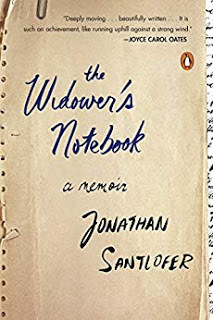

"Wrenching, heartbreaking, intense and emotional - but valuable, too: we're all approaching the age where this will happen to us - or to others because of us - and understanding that it can be dealt with is consoling. I don't know how Santlofer found the fortitude to write this, but I'm deeply grateful he did. I think the world is a better place with this book in it."—Lee Child, #1 New York Times bestselling author
“The Widower’s Notebook, Jonathan Santlofer’s searingly truthful chronicle of mortality, is, among its wonders, a book about the preciousness of life and love, rendered all the more heart-wrenching, and all the more vital, by a loss almost beyond imagining. It’s a true tragic beauty.”
—Michael Cunningham, Pulitzer Prize winning author of The Hours
“The Widower’s Notebook is a searing rendition of the complex relationship between men and grief—an intense despair that is too often starved for words. This chronicle of devastation is itself devastating, a deeply powerful and unflinchingly honest report of how painfully and strangely life continues in the wake of a sudden, tragic death.”—Andrew Solomon, National Book Award winner
"The Widower’s Notebook is an intimate, honest, heart-wrenching, and at times even funny account of grieving as well as the memoir of long, satisfying, loving marriage. This is an important and welcome addition to the literature of loss and grief from the male point of view. I will be giving this Notebook to friends reeling from loss but also to old and new couples who need models of how to weather the many little deaths and losses that occur as they journey a life together. Santlofer has given us a brave, beautiful gift, heartfelt and invaluable."
—Julia Alvarez, bestselling author of How the García Girls Lost Their Accents and Saving the World
“Widower is stunning, harrowing, un-put-down-able… Jonathan Santlofer finds language that is immediate and intimate for the irreconcilable trauma of loss. Without pause he captures the shattered time that is grief—this book is fearless, brave for its humanity, honesty, love. Santlofer brings the reader into his heart, sharing all the things that one feels but dares not say aloud, all that one wants to know but can’t ask of themselves, of those around them, of their lost loved one.”—A.M. Homes, author of May We Be Forgiven
"As an extended meditation - not on grief but on grieving - it is direct, unadorned and humane. It is, as well, a rare thing, a portrait of a happy marriage."—Paul Theroux, New York Times bestselling author
"Jonathan Santlofer's book is a miraculous act of seeing, in words and in drawings — of reconstituting, in a work of art, what his wife Joy was like and what their marriage was like and what the loss has been. A riveting memoir of grief, and an indelible portrait of a long and deeply good marriage." —Joan Wickersham, National Book Award finalist and author of The Suicide Index
"A brave book! A truthful and poignant account of an unexpected death filled with wisdom about life and a man's struggle to be allowed to grieve."—Sheila Kohler, author of Once We Were Sisters
“Jonathan Santlofer, with painful honesty, renders real grief in all its sprawl and inconsolable intensity.”—Edmund White, author of A Boy’s Own Story
"Jonathan Santlofer’s stunning The Widower’s Notebook raises all the blinds on immense and sudden loss, bringing light to all its dark corners. In so doing, he offers a deeply moving, often funny, always big-hearted portrait—not just of grief but of a long and rich marriage brought to vivid life, and of a mighty father-and-daughter relationship both tested and enduring. A true gift."—Megan Abbott, bestselling author of You Will Know Me
-
Jonathan Santlofer is a writer and artist. His debut novel, The Death Artist, was an international bestseller, translated into seventeen languages, and is currently in development for screen adaptation. His fourth novel, Anatomy of Fear, won the Nero Award for best novel of 2009. His short stories have appeared in numerous anthologies. He is also the creator and editor of several anthologies including It Occurs to Me That I Am America, a collection of original stories and art. His paintings and drawings are included in many public and private collections.
Thank you so much for being here, Jonathan!
What was the “why now” moment for you to write this brave and moving book?
Thank you for those kind words. I’m not sure there was one specific moment I could point to. For almost two years after my wife’s death I kept notebooks where I documented my days and nights, my interactions with friends and associates, even strangers. The notebooks were for me alone, a way to see clearly at a time when I could not. When I was invited to the arts colony, Yaddo, I thought I would work on a novel I’d started before my wife’s death, but got there and found I was still unable to concentrate on fiction and began transcribing my notebooks. I still didn’t think of it as a book, at least not one I would put into the world. What changed was allowing a few friends to read parts of what I’d written, all of whom were enthusiastic and urged me to consider publishing what I’d written. One writer friend, who I respect tremendously, said “Men do not write these kind of book, so you must continue, must finish.” Still, until the moment I sold the book I kept thinking I’m not going to do this!
So much of The Widower’s Notebook is about how males are supposed to act grieving, which is stoic, quiet, moving on. And which is nonsense. Can you talk about this please?
I think I fit the male pattern of grieving you describe very well—or did. I rarely if ever let anyone see what I really felt. I hid behind my mask of cool and funny, which in fact made the grieving process that much worse by making me feel isolated. It’s one of the things that eventually spurred me on to write this book—to express what I felt in a culture that doesn’t want to deal with loss and grief and does not expect it from a man. There are cultural stereotypes and expectations about the way women grieve versus the way men do, all ridiculous and equally punishing.
I loved that you binge-watched Netflix. When my mother had a stroke and began the process of dying, I found myself watching horror movies on my computer for hours at a time. Sometimes, I think, we need stories that are nothing like ours, to move forward. But some times, we need stories like yours, which make us feel that we are not alone, that we are all bound by love and loss. Was there ever a point where you felt, no, I can’t continue writing this?
I’m very sorry to hear about your mother. I think losing one’s mother is enormous, and I know my daughter would agree. I also agree that there are times we need distraction – 50 nonstop episodes of Breaking Bad or House of Cards - but there are those other times when we absolutely need to read other people’s experiences of loss for exactly the reason you say – to not feel alone. For well over a year I couldn’t read anything but when I started again all I read were memoirs about loss. I sometimes think a combination of work, friends, Netflix, and Joan Didion saved my life!
There were many times I thought, I can’t keep writing this because it’s too painful. And yet, I know the act of writing helped me move forward. At a certain point I had to step back and look at it as a book, a work on its own, a process that was a bit unnerving—to edit and structure something this personal—but I also felt, If I’m going to do this it had better be good!
Was there a difference in the way art and writing helped you?
I feel lucky that I had my art and writing because they were places to put what I was feeling into something tangible. When you make a drawing you have to coordinate your hand and eye, really concentrate on seeing, so it’s a great escape. I have often recommended learning to draw (and I believe everyone can) to others because it sharpens your mind in a very particular way and makes you see the world differently. I couldn’t actually escape when I was writing because it was all about what had happened, but there was something about constructing words and sentences—no matter how painful—that felt good and worthwhile. I firmly believe that work of any kind is a great mechanism to deal with grief. It doesn’t matter what it is—cooking, gardening, painting, learning a language, anything that forces you to focus—because it takes you out of the moment and makes you think about something else. Grieving takes time no matter what, but if you’re doing somethingat least part of that time moves faster.
What’s obsessing you now and why? (And what are you working on next, too, please)I just finished the novel I’d started before my wife died. It’s an historical thriller that mixes fact and fiction, something I’ve never done before. It was a difficult but very fun book to write. I’m painting too, and always drawing, which is relaxing for me. Once I finish editing the new novel I want to start another – an idea that’s been percolating in the back of my mind for a while now. After my wife died I couldn’t work at all so it now feels as if I’m making up for that time. I sometimes think, Oh, just stop, relax and shut up! But I can’t. I’m really only happy when I’m working, and I’ve grown to accept that.
What question didn’t I ask that I should have?The question I ask myself is: how am I feeling now? The Widower’s Notebook ends at a certain point, but as time goes on I feel more like myself. I’m a somewhat different, altered person than I was before, but I am no longer in the throes of grief and I think people need to hear that: to know that they will survive and feel better, because when you’re deep in grief you can’t imagine ever feeling better, but you will.
Published on July 15, 2018 17:44
July 9, 2018
How do you get to be a writer/actor/dancer/performer all at once? The amazing Tom Frueh tells all!
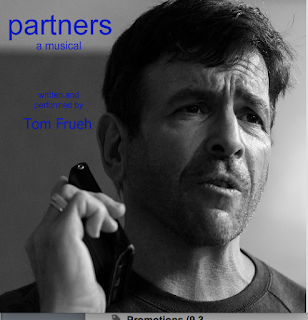
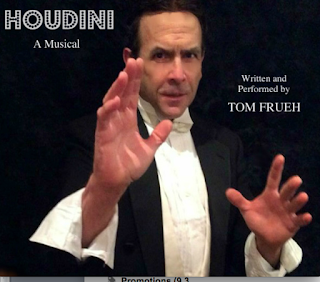

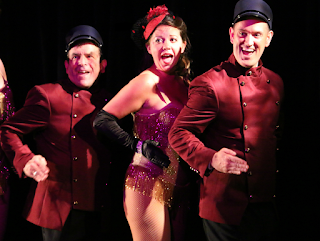
TOM FRUEH is a writer and actor who performs regularly in musicals, including his own one-man musicals for which he also writes the music, book and lyrics. His newest musical Partners recently had its world premiere on Theatre Row at the United Solo Theatre Festival, the world's largest festival devoted to solo theatre. Prior to that, his musical Houdini was produced there. He is also the author of numerous plays which have been performed in New York. A singer-dancer and veteran musical theatre performer, some of his other recent appearances include the musicals On the Twentieth Century, City of Angels, Hairspray, Grand Hotel, The Drowsy Chaperone and Cabaret.
Way, way back, when I lived in the city that shall not be named because I hated it so much, I studied ballet, and quickly became friends with Tom Frueh, who was funny, sarcastic, and as passionate about the arts as I was. Tom moved to Manhattan, and I followed his lead a few years later, and we’ve stayed friends. I’ve been to his plays and have been amazed. I’ve watched his solo shows with delight. And I wanted to interview him because he has so much to say about creativity.
Thank you so much Tom!
I’m so deeply interested in hearing you talk about your one-man musical shows and how they came to be, especially since they’re a bit like a novel. Like Lily Tomlin and many other performers and writers, I was heavily influenced by an actress who was also a writer, Ruth Draper. As a young woman, she wrote some monologues for herself but then didn’t know what to do with them. She showed them to the author Henry James and asked his advice. He replied, “My dear young friend, you have woven yourself a magic carpet - stand on it!”Draper’s career was perfecting these monodramas, and in performing them, she could display not only her writing and acting skills, but her amazing understanding and empathy for human beings at all levels of society, from a poor Scottish immigrant to a wealthy Manhattan dilettante and all sorts of people in between (she was also great with dialects).In a way, these monodramas were not unlike a novelist reading aloud from his or her own work, although there happens to be simple staging and props and lighting thrown in! And like reading from a novel, it’s storytelling in a more personal oral form. And that’s very similar to how I feel about my one-person shows (whereas when I do another author’s musical with a big cast, like On the Twentieth Century which I just finished, it’s something very different. Both are theatre, both are thrilling, but the solo show is a very writerly and a more personal journey and experience.)What’s your process like?
There’s a very close link between creating a character for a book or play and creating a character one is going to play onstage. For me, the processes are essentially the same, as are the research aspects. Non-theatre writers try to explore (and sometimes even experience first-hand) what their characters might have experienced, and certainly that’s a common practice for acting. So, in the case of my one-man shows, there’s that kind of research and discovery and character building, and then I try and find the right structure for the story. Acting is the last layer and an outgrowth of all that came before. Also, the acting piece can inform any rewriting. Often, I’ll find that a character I’ve written on the page seems to have his or her own distinct voice, but then I learn through speaking it and acting it that it was too infused with my own voice, so I go back and work to correct that.The fact that I started out writing plays and now write musicals is simply a matter of using the music skill to enhance the storytelling. In the case of my most recent solo musical Partners, which is about my life following the death of my partner, Johan Renvall, I never could have fully expressed the grief I felt without music, because I couldn’t talk about it at first – I was too devastated. I simply went to the piano and started playing what I was feeling. And then the words followed, and then words and music started to develop in parallel, and that became the complete picture. But the emotion of doing it was sometimes overwhelming. The support and discipline of my director, Jen Jurek, and my music director, Chris Piro, helped me bring it to performance level yet still allow the emotion to come through honestly, but without letting it overtake me.You’ve said that your shows came about because of grief, which I find fascinating. Talk about that please.
I don’t even think I was fully aware of that when I started writing my one-man shows, especially since grief was not always the central action in the shows. But grief was the momentous occurrence that made me write in the first place. My first solo show, After the Show with the Man Who Owned Broadway, about the composer and performer George M. Cohan, was written in part as a response to my father’s death, but it was about Cohan fearing his career was over. I wrote Houdini in response to my mother’s death, but it was about the climax of his career. Partnersis the only one of the three that is explicitly about navigating grief, which can be like wandering alone in total darkness. I wasn’t trying to write for therapy (even though there was some therapeutic value, but the writing process also accentuated the despair) but rather to try and create something beautiful from something horrible, and to make this awful experience “count” for something. I suppose there’s also an element in each of my solo shows about making art – both for me and the characters – to try and overcome life’s horrors. In my George M. show, he uses music and theatre to please an audience but also his dead father. In my piece about Houdini, he uses his seemingly magical escapes to defy the inevitability of nature, and to express his refusal to be beaten by anything or anyone. And since I dance in musicals and Johan was a dancer with American Ballet Theatre, Partnersuses dance as a metaphor for life and for the need to persist despite overwhelming tragedy.You do so many, many things all at once, and I know you also have a job. How do you manage this balancing act?
Yes, I do have a writing job and it encompasses just about anything one could think of, from all kinds of marketing and advertising writing to scripts and magazine articles. The balancing part is second nature to me now since I’ve been doing it so long, but the effort is so worth it because it’s made me a much better writer than I could have been without it. A few weeks ago, I took my very first figure drawing class thanks to a good friend. I thought I would go in and have an hour or more to leisurely sketch the model. But we only had three minutes and then the model changed poses! It was do or die, with ongoing feedback from the instructor. It was easy to see there was a method to this madness, and it’s much like my daily writing. The discipline of inflexible deadlines, the need to be creative on the spot, often with little information to go on, the necessary economy, and the regular criticism are all part of what any writer must accept, to one degree or another, in order to improve. It’s made me think faster and more efficiently when writing, and the best benefit of all is that it makes almost any tough writing job or problem seem conquerable. It’s been a blessing, and I’m grateful.What’s obsessing you now and why?The urgency to keep writing and performing in musicals for more audiences in more places more often, as well as I possibly can. Piece of cake, right?What question didn’t I ask that I should have? “When will we go to an all-night diner in Chelsea again and make mischief, and which one of us will write about it, and why is your last name pronounced ‘free’?” (Sorry, that’s really three little questions disguised as one big question!)
Learn more about Tom and his projects at tomfruehmusicals.com
Published on July 09, 2018 12:49
The amazing Maggie Balistreri talks about The EVASION-ENGLISH DICTIONARY, why we must say what we really mean, and how speech shapes politics--and more, more, more.
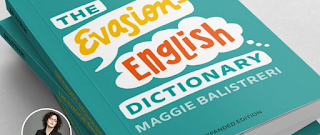 The very cool book with a tiny inset of Maggie
The very cool book with a tiny inset of Maggie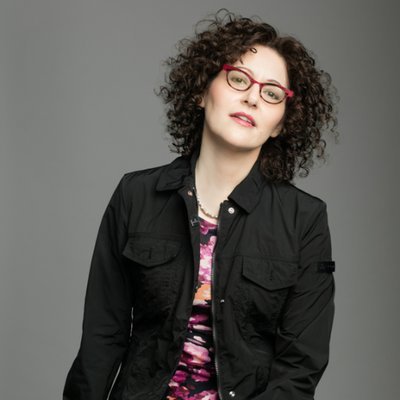 Here is a better portrait of the artist as unbelievably cool
Here is a better portrait of the artist as unbelievably coolMaggie Balistreri is a namer, taxonomist, and extraordinary author of THE EVASION-ENGLISH DICTIONARY. Hey folks, it's a must-have for these difficult times. So buy several copies and give to everyone you know. I did.
Thank you, Maggie.
I almost always ask people what was the why now moment for writing a book, but it seems like you have timed this one perfectly. Care to talk about this?
I wanted the book published before books are banned.
Tell us about what you call “evasion English.”
Evasive English = “I say this but I mean that” or “I say this because I mean that.” It’s the difference between my speech bubble and my thought bubble. I identify terms that help us avoid the intimacy of a direct statement; or words that, like icebergs, have unspoken depths of meaning.
Another way to think of the term “Evasion-English” is through its anagrams, which range from identification to interpretation:
● heaviness lingo ● gosh, insane evil ● asshole veining ● legion vanishes and ● eases living, hon
Phrases that “lead to what we really mean” is also revolutionary, and a great way to decode politicians, I think. Should we be speaking up more about this when we encounter it? I wish we all would.
Some evasions intend to spare someone else’s feelings. Other evasions are revolting manipulations. Some of the book is descriptive, and some is prescriptive according to my whim and fancy. It’s really choose-your-own-adventure when it comes to speaking up or modifying your own speech. I’m fascinated to hear which words annoy you.
I don’t take my own advice. The whole “I don’t know = no” entry (“They want to stay here with us? for the week? Huh. I don’t know”) was me Thursday. Sometimes I speak up and sometimes I fuck up.
Jason Bateman was in a movie with Katharine Hepburn in the 90s. Yup. Anyway here’s how he described her: “She only wore white Reebok high-tops, so for a dress-up scene, she’d just pull black socks over them. That’s what she was like. She hit ‘Fuck it’ a long time before I met her.”
We’ve all hit “Fuck it” by now. The time is shorter now for us to not speak up when it comes to larger, political discussions. And people are speaking up, thankfully. I could not bother living if I didn’t have the sanity check of hearing and reading so many and such quick interpretations of evasive language from public figures, more and more every day, getting back to your point about the timing of this book to coincide with the dismantling of wor(l)ds and meaning.
We see tweets with edit marks and “fixed it for you” or “you misspelled xxx” with the translation added. All of this is a reaction to evasion and bullshit and shows how many people are for holding people accountable for their words. Who could have predicted that editing marks would emerge from behind the curtains as much as they have and that the dictionary would be as cited as it is outside of the uninspired opening sentence to a class assignment.
Editing, correcting, rewriting, interpreting, translating, and analyzing are different ways to care and pay attention, and if anything can get us out of this mess of the boast of unpreparedness; the reliance on off-the-cuff bumbling; wielding power instead of employing authority, it’ll be those caring actions. Keep hitting pause and saying, “Wait, wha? That doesn’t make sense. I don’t get it because it’s not gettable.”
How did you come up with the terms that confuse meaning—like actually, but, whatever—What was your whole writing/research process like? What surprised or disturbed you?
The book comprises 2 types of entries: taxonomies of alternately maligned and defended words (like, actually, so, sorry, whatever) and terms with suggested translations that I present as equations (if = thatas in “I’m sorry if I hurt you”; but = bu(llshi)t as in “We see the merit in this word and thank you for sharing it with us... but we have decided not to accept it for publication”).
For each entry, I wrote example sentences to illustrate the nuances or to show how the substituted term could work. Those illustration sentences are from my imagination informed by years of hearing and saying stuff. With only two exceptions in the book, I didn’t include a quote verbatim. I wrote the sentences by improvising monologues or dialogues, sometimes out loud like a lunatic until I got the characterization they way I wanted it; and then selecting the sentences that show the term’s range.
An entry comes together with four ingredients: the term up at the top, a one-sentence interpretation or definition, an intro, and then example sentences.
I write down everything, starting in my Notes app. I have a good memory. Don’t sit behind me in a restaurant.
I just looked at my Notes app and see that many of my notes tend to be: ● one term at the top with a question mark (disrupt; would; empower) ● a sentence that caught my big grandpa ear (“I’d be great at maintaining a double life”) ● a quote, especially if there’s a universal rejection of or love for it (“The future is female”) ● a beautiful typo (after a breakup, I got some forwarded mail on which someone had scrawled “doesn’t love here anymore”) ● a fact that feels like a metaphor (“the fruit of the medlar is edible only in its decaying state”)
I use a spreadsheet to gather the bits and move things around to see what hangs together. When two cards are a match in the big game of Concentration I got going on in my head, I get to it.
What surprised me: ● The first ten terms I wrote about when I started this expanded edition, the terms that got me thinking about updating the book, didn’t make the cut. ● I’ve somewhat warmed to like and so. ● The same familiarity did not breed consent for some of the other terms. The more time I spent improvising with the word actually, the less I could stand hearing it. ● Wow, people are still getting up there and saying “I’m sorry if” in their public apologies even though it has been received warmly and without criticism exactly never times.
What disturbed me: It disturbs me to think that some people are more disturbed by the word fuckthan by the deed of fucking people over.
What comes across so clearly is your absolute love and devotion to language. Where did this come from? Were you a little girl who loved the dictionary?
You got it. I’m first generation and mine is the first in my family to get formal schooling. My parents worked as kids. How they would have loved a childhood in school instead of working.
their lives:my life::Dickensian:Dickens
We spoke Italian and Sicilian at home, English outside of the home. I was hyper aware of words-as-words because there was a ton of code shifting needed, always.
We were working class. I didn’t know anyone who had many things. The school library was everything. At home we had: the dictionary, an encyclopedia (which my brother read straight through like a gripping serialized novel), and an encyclopedia of the natural world. I mistyped that as “natural word.” I flipped through the dictionary over and over, and here I am all these years later a namer and taxonomist.
I also had a magical teacher in elementary school, Mrs. Fitzpatrick. She flipped the switch from black and white to color. She wasn’t even my teacher, but she ran the library, so we were pals. She used odd words, old-timey slang, and idiomatic expressions. She was wildly funny, and she had a great reading voice. She was the first English speaker I heard doing something with words, for kicks. I wanted a piece of that action. She said, “Read the dictionary. It’s all there, knucklehead.”
The dictionary is the great equalizer. It’s the democratic artifact, attending equally to every word. Its organization and presentation are marked by a judicious leaving alone; there’s very little in a dictionary by way of editorializing aside from the occasional indication that a word is “obsolete” or “considered vulgar.” Mostly, it leaves it up to you. And by it I mean the greatest humans we have, lexicographers.
Without the context of “This word is on your reading level; that one is not,” I got to decide for myself, sometimes regrettably. In 3rd grade, a classmate asked if I liked fresh figs. I started from Italian and found what I thought was the right cognate. I said, “perforce!” The schoolyard record skipped. The wilds of Brooklyn let me know: “nope.”
As kids, we didn’t have children’s versions of things, whether the things were objects or realities. “That’s the stove and this is a saw; attenzione (sta’ttendu).” I was welcome to sit with my mother and her friends as they discussed how things were, for women, for immigrants, for people without a lot of money. They discussed reproductive health and family scandals and tended to reenact rather than sum up conversations; no idea why I remember that but it’s still my preferred way to hear you tell a story. Don’t come at me with, “I met with Gretchen. She said okay.” No. Act it out for me complete with different voices, please.
I was the neighborhood writer and translator. Letters and phone calls to insurance companies and union reps; drafting a last will and testament. I translated medical information, which still gives me the sweats to think about because the stakes were so high.
Thrillingly questionable unrestricted access to the adult world, for which I’m mostly grateful.
I also think that not only is this book so helpful with political discourse going on today, but how can it not help us to be wiser, better, more open people?
Fingers crossed. If I use my own suggestions in the book and replace this term with that one, an unavoidable consequence will be intimacy, so it is about being more open. And when I use an evasion, I can consider how the unspoken meaning made you feel. Am I up for it?
What’s obsessing you now and why? (Besides language, of course!)
This morning: Would codpieces not make men more vulnerable? How would that change everything or anything? Can we try it for 50 years? And which of my neighbors is not breaking down their boxes even though “we’re living in a society”?
What question didn’t I ask that I should have?
“If you were to index essential human qualities, what would be the top-tier term with the greatest number of subentries?”
Oof. That’s a tough question, Caroline. I’ll go with: imagination I considered compassion ...but I think I can subsume compassion under imagination. No surprise a conservative group wanted to ban the word imagination from a children’s book.
Published on July 09, 2018 10:09
Eric Beck Rubin talks about his brilliantly unsettling new novel SCHOOL OF VELOCITY, playing piano and so much more.
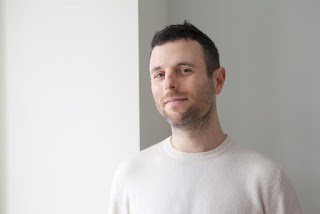

First, the raves:
Shortlist, Vine Awards 2017
Shortlist, Kobo Emerging Writer Prize 2017
Finalist, Frank Hegyi Award for Emerging Authors 2017Guardian/Observer Best Books 2016
Amazon Rising Stars 2016, for Best Debuts
CBC Books Best Canadian Debuts 2016
"A taut novel that builds tension to thriller level" – The Guardian
"Gripping and emotional" – The Observer
"A gut-punching confrontation" – Publishers Weekly
"A storm of a novel that resounds long after its heartbreaking coda" – The Guardian Sunday Review "A meditation on the impossibility of reliving the past, however much we cling to our memories" – Financial Times
"[Reminiscent] of Patricia Highsmith's The Talented Mr Ripley" – Irish Times
"About deciding, or even knowing, what the people we desire most really mean to us" – LA Review of Books
Writers know writers know writers. I met Eric Beck Rubin through my screenwriting partner and fellow novelist Gina Sorell (If you haven't read Mothers and Other Strangers, what the heck are you waiting for?) Eric sent me his book, SCHOOL OF VELOCITY and I went crazy for it.
He is a cultural historian who writes on architecture, literature, and psychology. SCHOOL OF VELOCITY is Eric's first foray into fiction, and he is currently at work on a second: a family saga spanning several generations, from pre-World War II Germany to present-day Los Angeles and Western Canada.
I don’t think I’ve ever been so disturbed or unsettled by a novel in years and years. Were you unsettled writing it? Did you know what was going to happen?
Oh, I’m very happy to hear that. I wanted this book to churn up those kinds of feelings in the reader. From my side, though, I wasn’t unsettled while writing. I adopted the narrator’s demeanor: deliberate, reserved, on guard for the surprise that might be around the corner (not that it helps him see what’s coming). As for the ending – I always had a vision of the final scene, and stayed faithful to it. But in one of the later drafts I added something. It took me by surprise, and I figured it would probably do the same for the reader.
What kind of writer are you? Can you tell us about your process?
I learned to write by imitating what I read. I adopted styles and forms from others and gradually the edges softened enough for me to develop something different. The way I see it, fiction closely resembles life, except that while there are no limits to what happens in life, there are limits to what you can put in a novel. So I start by trying to remember as much as possible about ‘what happened’, to take in the full spectrum of life, then shave the corners when pace and plausibility call for it.
I always want to know the why now moment when you felt you absolutely had to write this book. Can you talk about this please?
That I can answer. I was in the Netherlands, at a language school, when a Dutch friend told me to visit his old friend, who was living in the city of Maastricht. All I knew was that the two of them used to be best friends, and this person (in Maastricht) was the one who initiated my friend into music, girls, life, etc. When I went to this person’s apartment, what I saw was a version of my own friend’s apartment, but a pathetic and impoverished one. Bookshelves, but half empty. Art, but poorly framed. A piano, but missing keys. It was like an illustration – or x-ray – of what goes into a best friendship: closeness, competition, striving, failing. It was fascinating, and I didn’t sleep at all that night because I thought I had the heart of a story.
I love all the music material. Are you also a musician, and if not, what was your research like?
I’m an amateur pianist; all I play is classical music, off a sheet, as my ear is terrible. In all the practising I did, though, I learned to love that kind of music, and one of the pleasures of writing School of Velocity was re-acquainting myself with my classical music collection and memories. I also sent the manuscript to a friend who is a professional musician, to get his two cents. As for the other type of music in this book – funk and soul – that was something I was introduced to as a teenager. It still has a strong effect on me – as it would anybody, I think. James Brown, Otis Redding, Percy Sledge, Curtis Mayfield – hello!
(Both sides of the novel’s soundtrack can be heard here: ericbeckrubin.com/the-soundtrack)
The novel is also very cinematic. Do you write with images in your mind?
What you’re getting is the strong impressions that landscapes make on me. In the case of the Netherlands, it’s the perfectly flat fields, the hoarfrost, the fog. It’s all very suggestive – the story emanates from it.
What is obsessing you and why?
If I can go off to the side, what I’m thinking about most right now is form. The story I’m currently writing is in many ways the opposite of School of Velocity: many characters, generations, locations. So how do all these pieces fit together? What does the shape say about the content, and vice-versa? Once again, I’m looking to others to see what they’ve done, and how I might find room in it for something new.
What question didn't I ask that I should have?
A-ha. There are general questions – can you name some of those authors you admire? There are particular questions – what have you read lately that’s been great? There are questions related to SoV – do you think a true best friendship can outlast the time in which it was formed? Do you think the ‘other side’ of School of Velocity, which is written in first person, will ever be told? But I’m not feeling short-changed.
Published on July 09, 2018 09:33
June 28, 2018
Meg Waite Clayton talks about BEAUTIFUL EXILES, Martha Gellhorne and Hemingway, how Hemingway appeared at Gellhorn's door with a cleaning bucket on his head, and why choosing titles is so damn hard.
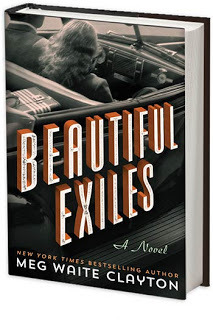
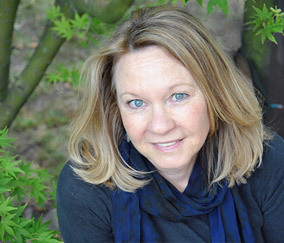
“Clayton uses her meticulous research skills to bring to life the wartime years of Martha Gellhorn… Clayton’s take on their boozy, love/hate relationship is packed with details of the war … a dramatic backdrop for her fictional tale of two vivid personalities and world-altering writers.” —Booklist (starred review)
I cannot remember where I first met Meg Waite Clayton, probably because it feels as if I've always known and loved her. I do, however, distinctly remember, her speckling on freckles on me for my clown costume for The Pulpwood Queens! And of course, I devour every book she writes.
She's a book club fave, and a New York Times and USA Today bestseller. Her books (and you need to read every one) include The Race For Paris, the Wednesday Sisters, The Language of Light and now Beautiful Exiles, about the relationship between Ernest Hemingway and Martha Gellhorn.
Thank for times a billion, Meg!
I always want to know what about your own life was haunting you into writing about Martha Gellhorn and Hemingway?
I wouldn’t say this one started with a haunting so much as an obsession.Like every other poor high school English student in this country, I slogged through The Old Man and the Sea long before I’d ever heard of The Trouble I’ve Seen or A Stricken Field. But I came to this story through Martha Gellhorn: I read about how she became one of the only journalists to go ashore in the early moments of the Normandy invasion, and I was hooked.
The Reader’s Digest condensed version of that story would go something like this: Denied an official opportunity to go across with the D-Day landing ships because she was female, Marty hid in the loo of the first hospital ship to cross the channel and went ashore with a stretcher crew to cover the landing in a brilliant article for Collier’s. As reward for her bravery, she was taken into custody, stripped of her press credential, and confined to a nurses’ training camp. But Marty, being Marty, hopped the fence and hitched a ride on a plane headed to Italy, where she continued do some of the best reporting to come out of the war even without her credential or any official support.
Really, how could I not want to know more about how Marty became Marty?
When I heard Caroline Moorehead’s Martha Gellhorn: A Life was to be published in October of 2003, I dug around to find a prepublication copy, which has long been underlined and dog-eared and loved to bits. I read her books, her articles, her letters. I visited places she’d been and tried to imagine being her, tried to learn everything I could. I discovered, among other things, that that first version of the D-Day story was a bit of an exaggeration: she didn’t hop that fence—she rolled under it!
I also discovered that she had been the lead correspondent for Collier’s until a man snagged the position from her—and that man was her husband, Ernest Hemingway.
For me, a novel is a long part of my life, all-consuming often for years. As Marty writes in an August 1940 letter to Charles Scribner, in explanation for why she is turning down a contract to write a book for Scribner’s, “I could not do a book (a book, Charlie, think of the high pile of bare white paper that you have in front of you before there is even the beginning of a book), unless I believed awfully hard in it. Unless I wanted to do it so much that I could sweat through the dissatisfaction and weariness and failure and all the rest you have to sweat through.”
I’ve been mopping the sweat from this one for a long time. My hope for what began as one of those high piles of white paper is that it will introduce others to the truly extraordinary Martha Gellhorn.
What about your research really surprised you?
Probably that Ernest Hemingway once stripped to his long johns and knocked on Martha’s door with a cleaning bucket on his head, and brandishing a mop.
Seriously.
I know not all authors are with me on this, but I feel if I am dealing with real people, I ought to honor their lives as they were lived. To intentionally make up stories about real people seems to me to lean on the crutch of a famous name in service of a story that ought to be able to stand on its own. And ... let’s just say I can’t imagine portraying Ernest Hemingway in long johns, cleaning bucket and mop if I didn’t have a basis in fact for it.
As might be expected for a story that begins with one clandestine relationship and ends with another—and involving people as famous as Martha Gellhorn and Ernest Hemingway—the many sources I turned to in the writing of Beautiful Exiles often differed on even the simplest of things, including who was where when. I sorted through those discrepancies as best I could, with the intent of being as true to the facts as possible. It was a bit like putting a puzzle together, taking little bits and pieces and turning them this way and that to see how they fit together.
I loved every minute of the research on this one—especially reading Martha’s letters, which are fabulous.
There’s a line in the book where Gellhorn talks about “the love, or whatever it was we shared.” I found this incredibly moving. In a different cultural climate, where there really was more equality between the sexes, do you think their relationship would have succeeded, or was it doomed to fail?
You had me at “incredibly moving.” (Thank you!)
I think a lot of the challenge in Ernest Hemingway and Martha Gellhorn’s relationship came from Ernest’s need to be seen as manly and Martha’s need to be free. No doubt the times played some part in that, but only so much—as I think we continue to see even eighty years later.
Clearly he struggled emotionally, as a shockingly high percentage of great writers do. I’ve come to see that while some of that is amplified by culture, much of it is brain chemical.
But I do think anyone living the two-career life today, especially the two-career creative life, can learn a lot from their relationship. Even now, when women are no longer expected to abandon their dreams to support their husbands, the weight of the career-home balance tilts heavily to the female side of the scale. And where ambition is admired in men, it remains suspect in women. We need to get past that, right?
I absolutely love the title—and the cover. I know that these are both marketing decisions to some extent, but can you talk about how both came to be?
Thank you! I also love the cover, which I can take no credit for. There was only one thing I didn’t like about the original they sent me, which was that the woman in the car was wearing a prissy hat Marty would never wear. I was pleased as all get out when they fixed it!
On the title, the working title for this book was Mookie & Bug—two of the nicknames Marty and Ernest called each other—but my agent felt that title suggested a young adult novel.
Retitling a finished manuscript is, as I expect you know, a bit like renaming a fully-grown child just as she is submitting her college applications. I love the new title, but one part of me will always think of this novel as Mookie & Bug.
How I came to Beautiful Exiles?
Well, since I building from scratch, I brainstormed—just words that described Martha or the two of them or whatever. One of those was “travelers,” in part I suppose because of her Travels with Myself and Another. But that’s a hard word, and not particularly evocative.
So I looked at “traveler” in my thesaurus found “soujourners,” which for a short moment in time seemed evocative.
Heeding Hemingway’s advice about the Bible being a great source for titles, I did an online Bible search and came up with "Beloved, I urge you as sojourners and exiles to abstain from the passions of the flesh, which wage war against your soul." (1 Peter 2:11).
Not a policy I generally subscribe to, but still I tried out “Soujourners and Exiles.”
Which made me see how stilted “soujourners” was.
But Exiles!
Marty was a bit of an exile on her own, exiled by the expectations that came with being from a prominent St. Louis family, and by her complicated relationship with her father. But the word also felt right because Marty and Ernest together are essentially exiled by his fame. When they were first falling in love, he was already famous enough that, in the U.S. anyway, they would have been hounded by photographers. How can you possibly sort out a relationship in that glare? They went to Cuba for the privacy it afforded them to sort out whether they even really wanted a relationship.
So I tried to find something that would go with “exiles,” but in a surprising way, with one rule, which was that I wasn’t going to do a “The” title. All five of my previous novels are “The” titles and really it’s time to break the string.
The thing about Ernest and Marty’s exile is that in many ways, for many years, it worked for them. They did have the privacy to sort out how they felt about each other outside the glare of the press, for the most part. The place they created together—the Finca Vigía—is beautiful. And they were a beautiful couple, and beautiful writers. In the end and despite everything, I don’t think either of them ever loved anyone more. Their relationship was stormy, but I think their best work—for both of them—came out of their years together. So “beautiful”—I liked the double meaning: they are beautiful exiles, and their exile together allowed them to write beautifully, the kind of writing that they both wanted more than anything else.
What’s obsessing you now and why?
The state of journalism today, and especially the importance of reporting the truth. And the backward steps we seem to be taking in terms of women’s rights. Why? I care about the future, and am sick as hell about where we seem to be headed.
What question didn’t I ask that I should have?
“What’s next?” It seems to be a question everyone asks … but I no longer say for fear of jinxing myself!
THAT is one thing that haunts me, that I will somehow jinx myself or wake up or whatever, and this lovely dream life I have, spending my days writing books and hearing from readers who are moved by the stories I write, will be gone somehow. <!-- /* Font Definitions */ @font-face {font-family:"MS 明朝"; <span class="goog-spellcheck-word" style="background: yellow none repeat scroll 0% 0%;" id=":dg.342" tabindex="-1" role="menuitem" aria-haspopup="true">mso</span>-font-<span class="goog-spellcheck-word" style="background: yellow none repeat scroll 0% 0%;" id=":dg.344" tabindex="-1" role="menuitem" aria-haspopup="true">charset</span>:78; <span class="goog-spellcheck-word" style="background: yellow none repeat scroll 0% 0%;" id=":dg.346" tabindex="-1" role="menuitem" aria-haspopup="true">mso</span>-generic-font-family:auto; <span class="goog-spellcheck-word" style="background: yellow none repeat scroll 0% 0%;" id=":dg.351" tabindex="-1" role="menuitem" aria-haspopup="true">mso</span>-font-pitch:variable; <span class="goog-spellcheck-word" style="background: yellow none repeat scroll 0% 0%;" id=":dg.355" tabindex="-1" role="menuitem" aria-haspopup="true">mso</span>-font-signature:-536870145 1791491579 18 0 131231 0;} @font-face {font-family:"<span class="goog-spellcheck-word" style="background: yellow none repeat scroll 0% 0%;" id=":dg.368" tabindex="-1" role="menuitem" aria-haspopup="true">Cambria</span> Math"; <span class="goog-spellcheck-word" style="background: yellow none repeat scroll 0% 0%;" id=":dg.370" tabindex="-1" role="menuitem" aria-haspopup="true">panose</span>-1:2 4 5 3 5 4 6 3 2 4; <span class="goog-spellcheck-word" style="background: yellow none repeat scroll 0% 0%;" id=":dg.382" tabindex="-1" role="menuitem" aria-haspopup="true">mso</span>-font-<span class="goog-spellcheck-word" style="background: yellow none repeat scroll 0% 0%;" id=":dg.384" tabindex="-1" role="menuitem" aria-haspopup="true">charset</span>:0; <span class="goog-spellcheck-word" style="background: yellow none repeat scroll 0% 0%;" id=":dg.386" tabindex="-1" role="menuitem" aria-haspopup="true">mso</span>-generic-font-family:auto; <span class="goog-spellcheck-word" style="background: yellow none repeat scroll 0% 0%;" id=":dg.391" tabindex="-1" role="menuitem" aria-haspopup="true">mso</span>-font-pitch:variable; <span class="goog-spellcheck-word" style="background: yellow none repeat scroll 0% 0%;" id=":dg.395" tabindex="-1" role="menuitem" aria-haspopup="true">mso</span>-font-signature:-536870145 1107305727 0 0 415 0;} @font-face {font-family:<span class="goog-spellcheck-word" style="background: yellow none repeat scroll 0% 0%;" id=":dg.408" tabindex="-1" role="menuitem" aria-haspopup="true">Cambria</span>; <span class="goog-spellcheck-word" style="background: yellow none repeat scroll 0% 0%;" id=":dg.409" tabindex="-1" role="menuitem" aria-haspopup="true">panose</span>-1:2 4 5 3 5 4 6 3 2 4; <span class="goog-spellcheck-word" style="background: yellow none repeat scroll 0% 0%;" id=":dg.421" tabindex="-1" role="menuitem" aria-haspopup="true">mso</span>-font-<span class="goog-spellcheck-word" style="background: yellow none repeat scroll 0% 0%;" id=":dg.423" tabindex="-1" role="menuitem" aria-haspopup="true">charset</span>:0; <span class="goog-spellcheck-word" style="background: yellow none repeat scroll 0% 0%;" id=":dg.425" tabindex="-1" role="menuitem" aria-haspopup="true">mso</span>-generic-font-family:auto; <span class="goog-spellcheck-word" style="background: yellow none repeat scroll 0% 0%;" id=":dg.430" tabindex="-1" role="menuitem" aria-haspopup="true">mso</span>-font-pitch:variable; <span class="goog-spellcheck-word" style="background: yellow none repeat scroll 0% 0%;" id=":dg.434" tabindex="-1" role="menuitem" aria-haspopup="true">mso</span>-font-signature:-536870145 1073743103 0 0 415 0;} @font-face {font-family:"Times Roman"; <span class="goog-spellcheck-word" style="background: yellow none repeat scroll 0% 0%;" id=":dg.448" tabindex="-1" role="menuitem" aria-haspopup="true">mso</span>-font-<span class="goog-spellcheck-word" style="background: yellow none repeat scroll 0% 0%;" id=":dg.450" tabindex="-1" role="menuitem" aria-haspopup="true">charset</span>:0; <span class="goog-spellcheck-word" style="background: yellow none repeat scroll 0% 0%;" id=":dg.452" tabindex="-1" role="menuitem" aria-haspopup="true">mso</span>-generic-font-family:auto; <span class="goog-spellcheck-word" style="background: yellow none repeat scroll 0% 0%;" id=":dg.457" tabindex="-1" role="menuitem" aria-haspopup="true">mso</span>-font-pitch:variable; <span class="goog-spellcheck-word" style="background: yellow none repeat scroll 0% 0%;" id=":dg.461" tabindex="-1" role="menuitem" aria-haspopup="true">mso</span>-font-signature:-536870145 1342185562 0 0 415 0;} /* Style Definitions */ p.<span class="goog-spellcheck-word" style="background: yellow none repeat scroll 0% 0%;" id=":dg.473" tabindex="-1" role="menuitem" aria-haspopup="true">MsoNormal</span>, <span class="goog-spellcheck-word" style="background: yellow none repeat scroll 0% 0%;" id=":dg.474" tabindex="-1" role="menuitem" aria-haspopup="true">li</span>.<span class="goog-spellcheck-word" style="background: yellow none repeat scroll 0% 0%;" id=":dg.475" tabindex="-1" role="menuitem" aria-haspopup="true">MsoNormal</span>, div.<span class="goog-spellcheck-word" style="background: yellow none repeat scroll 0% 0%;" id=":dg.477" tabindex="-1" role="menuitem" aria-haspopup="true">MsoNormal</span> {<span class="goog-spellcheck-word" style="background: yellow none repeat scroll 0% 0%;" id=":dg.478" tabindex="-1" role="menuitem" aria-haspopup="true">mso</span>-style-<span class="goog-spellcheck-word" style="background: yellow none repeat scroll 0% 0%;" id=":dg.480" tabindex="-1" role="menuitem" aria-haspopup="true">unhide</span>:no; <span class="goog-spellcheck-word" style="background: yellow none repeat scroll 0% 0%;" id=":dg.482" tabindex="-1" role="menuitem" aria-haspopup="true">mso</span>-style-<span class="goog-spellcheck-word" style="background: yellow none repeat scroll 0% 0%;" id=":dg.484" tabindex="-1" role="menuitem" aria-haspopup="true">qformat</span>:yes; <span class="goog-spellcheck-word" style="background: yellow none repeat scroll 0% 0%;" id=":dg.486" tabindex="-1" role="menuitem" aria-haspopup="true">mso</span>-style-parent:""; margin:0in; margin-bottom:.0001pt; <span class="goog-spellcheck-word" style="background: yellow none repeat scroll 0% 0%;" id=":dg.494" tabindex="-1" role="menuitem" aria-haspopup="true">mso</span>-pagination:widow-orphan; font-size:12.0pt; font-family:<span class="goog-spellcheck-word" style="background: yellow none repeat scroll 0% 0%;" id=":dg.504" tabindex="-1" role="menuitem" aria-haspopup="true">Cambria</span>; <span class="goog-spellcheck-word" style="background: yellow none repeat scroll 0% 0%;" id=":dg.505" tabindex="-1" role="menuitem" aria-haspopup="true">mso</span>-<span class="goog-spellcheck-word" style="background: yellow none repeat scroll 0% 0%;" id=":dg.506" tabindex="-1" role="menuitem" aria-haspopup="true">ascii</span>-font-family:<span class="goog-spellcheck-word" style="background: yellow none repeat scroll 0% 0%;" id=":dg.509" tabindex="-1" role="menuitem" aria-haspopup="true">Cambria</span>; <span class="goog-spellcheck-word" style="background: yellow none repeat scroll 0% 0%;" id=":dg.510" tabindex="-1" role="menuitem" aria-haspopup="true">mso</span>-<span class="goog-spellcheck-word" style="background: yellow none repeat scroll 0% 0%;" id=":dg.511" tabindex="-1" role="menuitem" aria-haspopup="true">ascii</span>-theme-font:minor-<span class="goog-spellcheck-word" style="background: yellow none repeat scroll 0% 0%;" id=":dg.515" tabindex="-1" role="menuitem" aria-haspopup="true">latin</span>; <span class="goog-spellcheck-word" style="background: yellow none repeat scroll 0% 0%;" id=":dg.516" tabindex="-1" role="menuitem" aria-haspopup="true">mso</span>-<span class="goog-spellcheck-word" style="background: yellow none repeat scroll 0% 0%;" id=":dg.517" tabindex="-1" role="menuitem" aria-haspopup="true">fareast</span>-font-family:"MS 明朝"; <span class="goog-spellcheck-word" style="background: yellow none repeat scroll 0% 0%;" id=":dg.522" tabindex="-1" role="menuitem" aria-haspopup="true">mso</span>-<span class="goog-spellcheck-word" style="background: yellow none repeat scroll 0% 0%;" id=":dg.523" tabindex="-1" role="menuitem" aria-haspopup="true">fareast</span>-theme-font:minor-<span class="goog-spellcheck-word" style="background: yellow none repeat scroll 0% 0%;" id=":dg.527" tabindex="-1" role="menuitem" aria-haspopup="true">fareast</span>; <span class="goog-spellcheck-word" style="background: yellow none repeat scroll 0% 0%;" id=":dg.528" tabindex="-1" role="menuitem" aria-haspopup="true">mso</span>-<span class="goog-spellcheck-word" style="background: yellow none repeat scroll 0% 0%;" id=":dg.529" tabindex="-1" role="menuitem" aria-haspopup="true">hansi</span>-font-family:<span class="goog-spellcheck-word" style="background: yellow none repeat scroll 0% 0%;" id=":dg.532" tabindex="-1" role="menuitem" aria-haspopup="true">Cambria</span>; <span class="goog-spellcheck-word" style="background: yellow none repeat scroll 0% 0%;" id=":dg.533" tabindex="-1" role="menuitem" aria-haspopup="true">mso</span>-<span class="goog-spellcheck-word" style="background: yellow none repeat scroll 0% 0%;" id=":dg.534" tabindex="-1" role="menuitem" aria-haspopup="true">hansi</span>-theme-font:minor-<span class="goog-spellcheck-word" style="background: yellow none repeat scroll 0% 0%;" id=":dg.538" tabindex="-1" role="menuitem" aria-haspopup="true">latin</span>; <span class="goog-spellcheck-word" style="background: yellow none repeat scroll 0% 0%;" id=":dg.539" tabindex="-1" role="menuitem" aria-haspopup="true">mso</span>-<span class="goog-spellcheck-word" style="background: yellow none repeat scroll 0% 0%;" id=":dg.540" tabindex="-1" role="menuitem" aria-haspopup="true">bidi</span>-font-family:"Times New Roman"; <span class="goog-spellcheck-word" style="background: yellow none repeat scroll 0% 0%;" id=":dg.544" tabindex="-1" role="menuitem" aria-haspopup="true">mso</span>-<span class="goog-spellcheck-word" style="background: yellow none repeat scroll 0% 0%;" id=":dg.545" tabindex="-1" role="menuitem" aria-haspopup="true">bidi</span>-theme-font:minor-<span class="goog-spellcheck-word" style="background: yellow none repeat scroll 0% 0%;" id=":dg.549" tabindex="-1" role="menuitem" aria-haspopup="true">bidi</span>;} .<span class="goog-spellcheck-word" style="background: yellow none repeat scroll 0% 0%;" id=":dg.550" tabindex="-1" role="menuitem" aria-haspopup="true">MsoChpDefault</span> {<span class="goog-spellcheck-word" style="background: yellow none repeat scroll 0% 0%;" id=":dg.551" tabindex="-1" role="menuitem" aria-haspopup="true">mso</span>-style-type:export-only; <span class="goog-spellcheck-word" style="background: yellow none repeat scroll 0% 0%;" id=":dg.555" tabindex="-1" role="menuitem" aria-haspopup="true">mso</span>-default-props:yes; font-family:<span class="goog-spellcheck-word" style="background: yellow none repeat scroll 0% 0%;" id=":dg.561" tabindex="-1" role="menuitem" aria-haspopup="true">Cambria</span>; <span class="goog-spellcheck-word" style="background: yellow none repeat scroll 0% 0%;" id=":dg.562" tabindex="-1" role="menuitem" aria-haspopup="true">mso</span>-<span class="goog-spellcheck-word" style="background: yellow none repeat scroll 0% 0%;" id=":dg.563" tabindex="-1" role="menuitem" aria-haspopup="true">ascii</span>-font-family:<span class="goog-spellcheck-word" style="background: yellow none repeat scroll 0% 0%;" id=":dg.566" tabindex="-1" role="menuitem" aria-haspopup="true">Cambria</span>; <span class="goog-spellcheck-word" style="background: yellow none repeat scroll 0% 0%;" id=":dg.567" tabindex="-1" role="menuitem" aria-haspopup="true">mso</span>-<span class="goog-spellcheck-word" style="background: yellow none repeat scroll 0% 0%;" id=":dg.568" tabindex="-1" role="menuitem" aria-haspopup="true">ascii</span>-theme-font:minor-<span class="goog-spellcheck-word" style="background: yellow none repeat scroll 0% 0%;" id=":dg.572" tabindex="-1" role="menuitem" aria-haspopup="true">latin</span>; <span class="goog-spellcheck-word" style="background: yellow none repeat scroll 0% 0%;" id=":dg.573" tabindex="-1" role="menuitem" aria-haspopup="true">mso</span>-<span class="goog-spellcheck-word" style="background: yellow none repeat scroll 0% 0%;" id=":dg.574" tabindex="-1" role="menuitem" aria-haspopup="true">fareast</span>-font-family:"MS 明朝"; <span class="goog-spellcheck-word" style="background: yellow none repeat scroll 0% 0%;" id=":dg.579" tabindex="-1" role="menuitem" aria-haspopup="true">mso</span>-<span class="goog-spellcheck-word" style="background: yellow none repeat scroll 0% 0%;" id=":dg.580" tabindex="-1" role="menuitem" aria-haspopup="true">fareast</span>-theme-font:minor-<span class="goog-spellcheck-word" style="background: yellow none repeat scroll 0% 0%;" id=":dg.584" tabindex="-1" role="menuitem" aria-haspopup="true">fareast</span>; <span class="goog-spellcheck-word" style="background: yellow none repeat scroll 0% 0%;" id=":dg.585" tabindex="-1" role="menuitem" aria-haspopup="true">mso</span>-<span class="goog-spellcheck-word" style="background: yellow none repeat scroll 0% 0%;" id=":dg.586" tabindex="-1" role="menuitem" aria-haspopup="true">hansi</span>-font-family:<span class="goog-spellcheck-word" style="background: yellow none repeat scroll 0% 0%;" id=":dg.589" tabindex="-1" role="menuitem" aria-haspopup="true">Cambria</span>; <span class="goog-spellcheck-word" style="background: yellow none repeat scroll 0% 0%;" id=":dg.590" tabindex="-1" role="menuitem" aria-haspopup="true">mso</span>-<span class="goog-spellcheck-word" style="background: yellow none repeat scroll 0% 0%;" id=":dg.591" tabindex="-1" role="menuitem" aria-haspopup="true">hansi</span>-theme-font:minor-<span class="goog-spellcheck-word" style="background: yellow none repeat scroll 0% 0%;" id=":dg.595" tabindex="-1" role="menuitem" aria-haspopup="true">latin</span>; <span class="goog-spellcheck-word" style="background: yellow none repeat scroll 0% 0%;" id=":dg.596" tabindex="-1" role="menuitem" aria-haspopup="true">mso</span>-<span class="goog-spellcheck-word" style="background: yellow none repeat scroll 0% 0%;" id=":dg.597" tabindex="-1" role="menuitem" aria-haspopup="true">bidi</span>-font-family:"Times New Roman"; <span class="goog-spellcheck-word" style="background: yellow none repeat scroll 0% 0%;" id=":dg.601" tabindex="-1" role="menuitem" aria-haspopup="true">mso</span>-<span class="goog-spellcheck-word" style="background: yellow none repeat scroll 0% 0%;" id=":dg.602" tabindex="-1" role="menuitem" aria-haspopup="true">bidi</span>-theme-font:minor-<span class="goog-spellcheck-word" style="background: yellow none repeat scroll 0% 0%;" id=":dg.606" tabindex="-1" role="menuitem" aria-haspopup="true">bidi</span>;} @page WordSection1 {size:8.5in 11.0in; margin:1.0in 1.25in 1.0in 1.25in; <span class="goog-spellcheck-word" style="background: yellow none repeat scroll 0% 0%;" id=":dg.623" tabindex="-1" role="menuitem" aria-haspopup="true">mso</span>-header-margin:.5in; <span class="goog-spellcheck-word" style="background: yellow none repeat scroll 0% 0%;" id=":dg.627" tabindex="-1" role="menuitem" aria-haspopup="true">mso</span>-footer-margin:.5in; <span class="goog-spellcheck-word" style="background: yellow none repeat scroll 0% 0%;" id=":dg.631" tabindex="-1" role="menuitem" aria-haspopup="true">mso</span>-paper-source:0;} div.WordSection1 {page:WordSection1;} </style> --><br /><style><!-- /* Font Definitions */ @font-face {font-family:Times; <span class="goog-spellcheck-word" style="background: yellow none repeat scroll 0% 0%;" id=":dg.644" tabindex="-1" role="menuitem" aria-haspopup="true">panose</span>-1:2 0 5 0 0 0 0 0 0 0; <span class="goog-spellcheck-word" style="background: yellow none repeat scroll 0% 0%;" id=":dg.656" tabindex="-1" role="menuitem" aria-haspopup="true">mso</span>-font-alt:Times; <span class="goog-spellcheck-word" style="background: yellow none repeat scroll 0% 0%;" id=":dg.659" tabindex="-1" role="menuitem" aria-haspopup="true">mso</span>-font-<span class="goog-spellcheck-word" style="background: yellow none repeat scroll 0% 0%;" id=":dg.661" tabindex="-1" role="menuitem" aria-haspopup="true">charset</span>:0; <span class="goog-spellcheck-word" style="background: yellow none repeat scroll 0% 0%;" id=":dg.663" tabindex="-1" role="menuitem" aria-haspopup="true">mso</span>-generic-font-family:auto; <span class="goog-spellcheck-word" style="background: yellow none repeat scroll 0% 0%;" id=":dg.668" tabindex="-1" role="menuitem" aria-haspopup="true">mso</span>-font-pitch:variable; <span class="goog-spellcheck-word" style="background: yellow none repeat scroll 0% 0%;" id=":dg.672" tabindex="-1" role="menuitem" aria-haspopup="true">mso</span>-font-signature:3 0 0 0 1 0;} @font-face {font-family:"MS 明朝"; <span class="goog-spellcheck-word" style="background: yellow none repeat scroll 0% 0%;" id=":dg.687" tabindex="-1" role="menuitem" aria-haspopup="true">mso</span>-font-<span class="goog-spellcheck-word" style="background: yellow none repeat scroll 0% 0%;" id=":dg.689" tabindex="-1" role="menuitem" aria-haspopup="true">charset</span>:78; <span class="goog-spellcheck-word" style="background: yellow none repeat scroll 0% 0%;" id=":dg.691" tabindex="-1" role="menuitem" aria-haspopup="true">mso</span>-generic-font-family:auto; <span class="goog-spellcheck-word" style="background: yellow none repeat scroll 0% 0%;" id=":dg.696" tabindex="-1" role="menuitem" aria-haspopup="true">mso</span>-font-pitch:variable; <span class="goog-spellcheck-word" style="background: yellow none repeat scroll 0% 0%;" id=":dg.700" tabindex="-1" role="menuitem" aria-haspopup="true">mso</span>-font-signature:-536870145 1791491579 18 0 131231 0;} @font-face {font-family:"<span class="goog-spellcheck-word" style="background: yellow none repeat scroll 0% 0%;" id=":dg.713" tabindex="-1" role="menuitem" aria-haspopup="true">Cambria</span> Math"; <span class="goog-spellcheck-word" style="background: yellow none repeat scroll 0% 0%;" id=":dg.715" tabindex="-1" role="menuitem" aria-haspopup="true">panose</span>-1:2 4 5 3 5 4 6 3 2 4; <span class="goog-spellcheck-word" style="background: yellow none repeat scroll 0% 0%;" id=":dg.727" tabindex="-1" role="menuitem" aria-haspopup="true">mso</span>-font-<span class="goog-spellcheck-word" style="background: yellow none repeat scroll 0% 0%;" id=":dg.729" tabindex="-1" role="menuitem" aria-haspopup="true">charset</span>:0; <span class="goog-spellcheck-word" style="background: yellow none repeat scroll 0% 0%;" id=":dg.731" tabindex="-1" role="menuitem" aria-haspopup="true">mso</span>-generic-font-family:auto; <span class="goog-spellcheck-word" style="background: yellow none repeat scroll 0% 0%;" id=":dg.736" tabindex="-1" role="menuitem" aria-haspopup="true">mso</span>-font-pitch:variable; <span class="goog-spellcheck-word" style="background: yellow none repeat scroll 0% 0%;" id=":dg.740" tabindex="-1" role="menuitem" aria-haspopup="true">mso</span>-font-signature:-536870145 1107305727 0 0 415 0;} @font-face {font-family:<span class="goog-spellcheck-word" style="background: yellow none repeat scroll 0% 0%;" id=":dg.753" tabindex="-1" role="menuitem" aria-haspopup="true">Cambria</span>; <span class="goog-spellcheck-word" style="background: yellow none repeat scroll 0% 0%;" id=":dg.754" tabindex="-1" role="menuitem" aria-haspopup="true">panose</span>-1:2 4 5 3 5 4 6 3 2 4; <span class="goog-spellcheck-word" style="background: yellow none repeat scroll 0% 0%;" id=":dg.766" tabindex="-1" role="menuitem" aria-haspopup="true">mso</span>-font-<span class="goog-spellcheck-word" style="background: yellow none repeat scroll 0% 0%;" id=":dg.768" tabindex="-1" role="menuitem" aria-haspopup="true">charset</span>:0; <span class="goog-spellcheck-word" style="background: yellow none repeat scroll 0% 0%;" id=":dg.770" tabindex="-1" role="menuitem" aria-haspopup="true">mso</span>-generic-font-family:auto; <span class="goog-spellcheck-word" style="background: yellow none repeat scroll 0% 0%;" id=":dg.775" tabindex="-1" role="menuitem" aria-haspopup="true">mso</span>-font-pitch:variable; <span class="goog-spellcheck-word" style="background: yellow none repeat scroll 0% 0%;" id=":dg.779" tabindex="-1" role="menuitem" aria-haspopup="true">mso</span>-font-signature:-536870145 1073743103 0 0 415 0;} /* Style Definitions */ p.<span class="goog-spellcheck-word" style="background: yellow none repeat scroll 0% 0%;" id=":dg.791" tabindex="-1" role="menuitem" aria-haspopup="true">MsoNormal</span>, <span class="goog-spellcheck-word" style="background: yellow none repeat scroll 0% 0%;" id=":dg.792" tabindex="-1" role="menuitem" aria-haspopup="true">li</span>.<span class="goog-spellcheck-word" style="background: yellow none repeat scroll 0% 0%;" id=":dg.793" tabindex="-1" role="menuitem" aria-haspopup="true">MsoNormal</span>, div.<span class="goog-spellcheck-word" style="background: yellow none repeat scroll 0% 0%;" id=":dg.795" tabindex="-1" role="menuitem" aria-haspopup="true">MsoNormal</span> {<span class="goog-spellcheck-word" style="background: yellow none repeat scroll 0% 0%;" id=":dg.796" tabindex="-1" role="menuitem" aria-haspopup="true">mso</span>-style-<span class="goog-spellcheck-word" style="background: yellow none repeat scroll 0% 0%;" id=":dg.798" tabindex="-1" role="menuitem" aria-haspopup="true">unhide</span>:no; <span class="goog-spellcheck-word" style="background: yellow none repeat scroll 0% 0%;" id=":dg.800" tabindex="-1" role="menuitem" aria-haspopup="true">mso</span>-style-<span class="goog-spellcheck-word" style="background: yellow none repeat scroll 0% 0%;" id=":dg.802" tabindex="-1" role="menuitem" aria-haspopup="true">qformat</span>:yes; <span class="goog-spellcheck-word" style="background: yellow none repeat scroll 0% 0%;" id=":dg.804" tabindex="-1" role="menuitem" aria-haspopup="true">mso</span>-style-parent:""; margin:0in; margin-bottom:.0001pt; <span class="goog-spellcheck-word" style="background: yellow none repeat scroll 0% 0%;" id=":dg.812" tabindex="-1" role="menuitem" aria-haspopup="true">mso</span>-pagination:widow-orphan; font-size:12.0pt; font-family:<span class="goog-spellcheck-word" style="background: yellow none repeat scroll 0% 0%;" id=":dg.822" tabindex="-1" role="menuitem" aria-haspopup="true">Cambria</span>; <span class="goog-spellcheck-word" style="background: yellow none repeat scroll 0% 0%;" id=":dg.823" tabindex="-1" role="menuitem" aria-haspopup="true">mso</span>-<span class="goog-spellcheck-word" style="background: yellow none repeat scroll 0% 0%;" id=":dg.824" tabindex="-1" role="menuitem" aria-haspopup="true">ascii</span>-font-family:<span class="goog-spellcheck-word" style="background: yellow none repeat scroll 0% 0%;" id=":dg.827" tabindex="-1" role="menuitem" aria-haspopup="true">Cambria</span>; <span class="goog-spellcheck-word" style="background: yellow none repeat scroll 0% 0%;" id=":dg.828" tabindex="-1" role="menuitem" aria-haspopup="true">mso</span>-<span class="goog-spellcheck-word" style="background: yellow none repeat scroll 0% 0%;" id=":dg.829" tabindex="-1" role="menuitem" aria-haspopup="true">ascii</span>-theme-font:minor-<span class="goog-spellcheck-word" style="background: yellow none repeat scroll 0% 0%;" id=":dg.833" tabindex="-1" role="menuitem" aria-haspopup="true">latin</span>; <span class="goog-spellcheck-word" style="background: yellow none repeat scroll 0% 0%;" id=":dg.834" tabindex="-1" role="menuitem" aria-haspopup="true">mso</span>-<span class="goog-spellcheck-word" style="background: yellow none repeat scroll 0% 0%;" id=":dg.835" tabindex="-1" role="menuitem" aria-haspopup="true">fareast</span>-font-family:"MS 明朝"; <span class="goog-spellcheck-word" style="background: yellow none repeat scroll 0% 0%;" id=":dg.840" tabindex="-1" role="menuitem" aria-haspopup="true">mso</span>-<span class="goog-spellcheck-word" style="background: yellow none repeat scroll 0% 0%;" id=":dg.841" tabindex="-1" role="menuitem" aria-haspopup="true">fareast</span>-theme-font:minor-<span class="goog-spellcheck-word" style="background: yellow none repeat scroll 0% 0%;" id=":dg.845" tabindex="-1" role="menuitem" aria-haspopup="true">fareast</span>; <span class="goog-spellcheck-word" style="background: yellow none repeat scroll 0% 0%;" id=":dg.846" tabindex="-1" role="menuitem" aria-haspopup="true">mso</span>-<span class="goog-spellcheck-word" style="background: yellow none repeat scroll 0% 0%;" id=":dg.847" tabindex="-1" role="menuitem" aria-haspopup="true">hansi</span>-font-family:<span class="goog-spellcheck-word" style="background: yellow none repeat scroll 0% 0%;" id=":dg.850" tabindex="-1" role="menuitem" aria-haspopup="true">Cambria</span>; <span class="goog-spellcheck-word" style="background: yellow none repeat scroll 0% 0%;" id=":dg.851" tabindex="-1" role="menuitem" aria-haspopup="true">mso</span>-<span class="goog-spellcheck-word" style="background: yellow none repeat scroll 0% 0%;" id=":dg.852" tabindex="-1" role="menuitem" aria-haspopup="true">hansi</span>-theme-font:minor-<span class="goog-spellcheck-word" style="background: yellow none repeat scroll 0% 0%;" id=":dg.856" tabindex="-1" role="menuitem" aria-haspopup="true">latin</span>; <span class="goog-spellcheck-word" style="background: yellow none repeat scroll 0% 0%;" id=":dg.857" tabindex="-1" role="menuitem" aria-haspopup="true">mso</span>-<span class="goog-spellcheck-word" style="background: yellow none repeat scroll 0% 0%;" id=":dg.858" tabindex="-1" role="menuitem" aria-haspopup="true">bidi</span>-font-family:"Times New Roman"; <span class="goog-spellcheck-word" style="background: yellow none repeat scroll 0% 0%;" id=":dg.862" tabindex="-1" role="menuitem" aria-haspopup="true">mso</span>-<span class="goog-spellcheck-word" style="background: yellow none repeat scroll 0% 0%;" id=":dg.863" tabindex="-1" role="menuitem" aria-haspopup="true">bidi</span>-theme-font:minor-<span class="goog-spellcheck-word" style="background: yellow none repeat scroll 0% 0%;" id=":dg.867" tabindex="-1" role="menuitem" aria-haspopup="true">bidi</span>;} a:link, span.<span class="goog-spellcheck-word" style="background: yellow none repeat scroll 0% 0%;" id=":dg.870" tabindex="-1" role="menuitem" aria-haspopup="true">MsoHyperlink</span> {<span class="goog-spellcheck-word" style="background: yellow none repeat scroll 0% 0%;" id=":dg.871" tabindex="-1" role="menuitem" aria-haspopup="true">mso</span>-style-<span class="goog-spellcheck-word" style="background: yellow none repeat scroll 0% 0%;" id=":dg.873" tabindex="-1" role="menuitem" aria-haspopup="true">noshow</span>:yes; <span class="goog-spellcheck-word" style="background: yellow none repeat scroll 0% 0%;" id=":dg.875" tabindex="-1" role="menuitem" aria-haspopup="true">mso</span>-style-priority:99; color:blue; text-decoration:underline; text-underline:single;} a:visited, span.<span class="goog-spellcheck-word" style="background: yellow none repeat scroll 0% 0%;" id=":dg.888" tabindex="-1" role="menuitem" aria-haspopup="true">MsoHyperlinkFollowed</span> {<span class="goog-spellcheck-word" style="background: yellow none repeat scroll 0% 0%;" id=":dg.889" tabindex="-1" role="menuitem" aria-haspopup="true">mso</span>-style-<span class="goog-spellcheck-word" style="background: yellow none repeat scroll 0% 0%;" id=":dg.891" tabindex="-1" role="menuitem" aria-haspopup="true">noshow</span>:yes; <span class="goog-spellcheck-word" style="background: yellow none repeat scroll 0% 0%;" id=":dg.893" tabindex="-1" role="menuitem" aria-haspopup="true">mso</span>-style-priority:99; color:purple; <span class="goog-spellcheck-word" style="background: yellow none repeat scroll 0% 0%;" id=":dg.899" tabindex="-1" role="menuitem" aria-haspopup="true">mso</span>-<span class="goog-spellcheck-word" style="background: yellow none repeat scroll 0% 0%;" id=":dg.900" tabindex="-1" role="menuitem" aria-haspopup="true">themecolor</span>:<span class="goog-spellcheck-word" style="background: yellow none repeat scroll 0% 0%;" id=":dg.901" tabindex="-1" role="menuitem" aria-haspopup="true">followedhyperlink</span>; text-decoration:underline; text-underline:single;} p {<span class="goog-spellcheck-word" style="background: yellow none repeat scroll 0% 0%;" id=":dg.909" tabindex="-1" role="menuitem" aria-haspopup="true">mso</span>-style-<span class="goog-spellcheck-word" style="background: yellow none repeat scroll 0% 0%;" id=":dg.911" tabindex="-1" role="menuitem" aria-haspopup="true">noshow</span>:yes; <span class="goog-spellcheck-word" style="background: yellow none repeat scroll 0% 0%;" id=":dg.913" tabindex="-1" role="menuitem" aria-haspopup="true">mso</span>-style-priority:99; <span class="goog-spellcheck-word" style="background: yellow none repeat scroll 0% 0%;" id=":dg.917" tabindex="-1" role="menuitem" aria-haspopup="true">mso</span>-margin-top-alt:auto; margin-right:0in; <span class="goog-spellcheck-word" style="background: yellow none repeat scroll 0% 0%;" id=":dg.925" tabindex="-1" role="menuitem" aria-haspopup="true">mso</span>-margin-bottom-alt:auto; margin-left:0in; <span class="goog-spellcheck-word" style="background: yellow none repeat scroll 0% 0%;" id=":dg.933" tabindex="-1" role="menuitem" aria-haspopup="true">mso</span>-pagination:widow-orphan; font-size:10.0pt; font-family:Times; <span class="goog-spellcheck-word" style="background: yellow none repeat scroll 0% 0%;" id=":dg.943" tabindex="-1" role="menuitem" aria-haspopup="true">mso</span>-<span class="goog-spellcheck-word" style="background: yellow none repeat scroll 0% 0%;" id=":dg.944" tabindex="-1" role="menuitem" aria-haspopup="true">fareast</span>-font-family:"MS 明朝"; <span class="goog-spellcheck-word" style="background: yellow none repeat scroll 0% 0%;" id=":dg.949" tabindex="-1" role="menuitem" aria-haspopup="true">mso</span>-<span class="goog-spellcheck-word" style="background: yellow none repeat scroll 0% 0%;" id=":dg.950" tabindex="-1" role="menuitem" aria-haspopup="true">fareast</span>-theme-font:minor-<span class="goog-spellcheck-word" style="background: yellow none repeat scroll 0% 0%;" id=":dg.954" tabindex="-1" role="menuitem" aria-haspopup="true">fareast</span>; <span class="goog-spellcheck-word" style="background: yellow none repeat scroll 0% 0%;" id=":dg.955" tabindex="-1" role="menuitem" aria-haspopup="true">mso</span>-<span class="goog-spellcheck-word" style="background: yellow none repeat scroll 0% 0%;" id=":dg.956" tabindex="-1" role="menuitem" aria-haspopup="true">bidi</span>-font-family:"Times New Roman";} .<span class="goog-spellcheck-word" style="background: yellow none repeat scroll 0% 0%;" id=":dg.960" tabindex="-1" role="menuitem" aria-haspopup="true">MsoChpDefault</span> {<span class="goog-spellcheck-word" style="background: yellow none repeat scroll 0% 0%;" id=":dg.961" tabindex="-1" role="menuitem" aria-haspopup="true">mso</span>-style-type:export-only; <span class="goog-spellcheck-word" style="background: yellow none repeat scroll 0% 0%;" id=":dg.965" tabindex="-1" role="menuitem" aria-haspopup="true">mso</span>-default-props:yes; font-family:<span class="goog-spellcheck-word" style="background: yellow none repeat scroll 0% 0%;" id=":dg.971" tabindex="-1" role="menuitem" aria-haspopup="true">Cambria</span>; <span class="goog-spellcheck-word" style="background: yellow none repeat scroll 0% 0%;" id=":dg.972" tabindex="-1" role="menuitem" aria-haspopup="true">mso</span>-<span class="goog-spellcheck-word" style="background: yellow none repeat scroll 0% 0%;" id=":dg.973" tabindex="-1" role="menuitem" aria-haspopup="true">ascii</span>-font-family:<span class="goog-spellcheck-word" style="background: yellow none repeat scroll 0% 0%;" id=":dg.976" tabindex="-1" role="menuitem" aria-haspopup="true">Cambria</span>; <span class="goog-spellcheck-word" style="background: yellow none repeat scroll 0% 0%;" id=":dg.977" tabindex="-1" role="menuitem" aria-haspopup="true">mso</span>-<span class="goog-spellcheck-word" style="background: yellow none repeat scroll 0% 0%;" id=":dg.978" tabindex="-1" role="menuitem" aria-haspopup="true">ascii</span>-theme-font:minor-<span class="goog-spellcheck-word" style="background: yellow none repeat scroll 0% 0%;" id=":dg.982" tabindex="-1" role="menuitem" aria-haspopup="true">latin</span>; <span class="goog-spellcheck-word" style="background: yellow none repeat scroll 0% 0%;" id=":dg.983" tabindex="-1" role="menuitem" aria-haspopup="true">mso</span>-<span class="goog-spellcheck-word" style="background: yellow none repeat scroll 0% 0%;" id=":dg.984" tabindex="-1" role="menuitem" aria-haspopup="true">fareast</span>-font-family:"MS 明朝"; <span class="goog-spellcheck-word" style="background: yellow none repeat scroll 0% 0%;" id=":dg.989" tabindex="-1" role="menuitem" aria-haspopup="true">mso</span>-<span class="goog-spellcheck-word" style="background: yellow none repeat scroll 0% 0%;" id=":dg.990" tabindex="-1" role="menuitem" aria-haspopup="true">fareast</span>-theme-font:minor-<span class="goog-spellcheck-word" style="background: yellow none repeat scroll 0% 0%;" id=":dg.994" tabindex="-1" role="menuitem" aria-haspopup="true">fareast</span>; <span class="goog-spellcheck-word" style="background: yellow none repeat scroll 0% 0%;" id=":dg.995" tabindex="-1" role="menuitem" aria-haspopup="true">mso</span>-<span class="goog-spellcheck-word" style="background: yellow none repeat scroll 0% 0%;" id=":dg.996" tabindex="-1" role="menuitem" aria-haspopup="true">hansi</span>-font-family:<span class="goog-spellcheck-word" style="background: yellow none repeat scroll 0% 0%;" id=":dg.999" tabindex="-1" role="menuitem" aria-haspopup="true">Cambria</span>; <span class="goog-spellcheck-word" style="background: yellow none repeat scroll 0% 0%;" id=":dg.1000" tabindex="-1" role="menuitem" aria-haspopup="true">mso</span>-<span class="goog-spellcheck-word" style="background: yellow none repeat scroll 0% 0%;" id=":dg.1001" tabindex="-1" role="menuitem" aria-haspopup="true">hansi</span>-theme-font:minor-<span class="goog-spellcheck-word" style="background: yellow none repeat scroll 0% 0%;" id=":dg.1005" tabindex="-1" role="menuitem" aria-haspopup="true">latin</span>; <span class="goog-spellcheck-word" style="background: yellow none repeat scroll 0% 0%;" id=":dg.1006" tabindex="-1" role="menuitem" aria-haspopup="true">mso</span>-<span class="goog-spellcheck-word" style="background: yellow none repeat scroll 0% 0%;" id=":dg.1007" tabindex="-1" role="menuitem" aria-haspopup="true">bidi</span>-font-family:"Times New Roman"; <span class="goog-spellcheck-word" style="background: yellow none repeat scroll 0% 0%;" id=":dg.1011" tabindex="-1" role="menuitem" aria-haspopup="true">mso</span>-<span class="goog-spellcheck-word" style="background: yellow none repeat scroll 0% 0%;" id=":dg.1012" tabindex="-1" role="menuitem" aria-haspopup="true">bidi</span>-theme-font:minor-<span class="goog-spellcheck-word" style="background: yellow none repeat scroll 0% 0%;" id=":dg.1016" tabindex="-1" role="menuitem" aria-haspopup="true">bidi</span>;} @page WordSection1 {size:8.5in 11.0in; margin:1.0in 1.25in 1.0in 1.25in; <span class="goog-spellcheck-word" style="background: yellow none repeat scroll 0% 0%;" id=":dg.1033" tabindex="-1" role="menuitem" aria-haspopup="true">mso</span>-header-margin:.5in; <span class="goog-spellcheck-word" style="background: yellow none repeat scroll 0% 0%;" id=":dg.1037" tabindex="-1" role="menuitem" aria-haspopup="true">mso</span>-footer-margin:.5in; <span class="goog-spellcheck-word" style="background: yellow none repeat scroll 0% 0%;" id=":dg.1041" tabindex="-1" role="menuitem" aria-haspopup="true">mso</span>-paper-source:0;} div.WordSection1 {page:WordSection1;} </style> -->
Published on June 28, 2018 15:25
Oh yes, the genius Thrity Umrigar talks about THE SECRETS BETWEEN US, class and women in both India and America, keeping our hearts open, and so much more
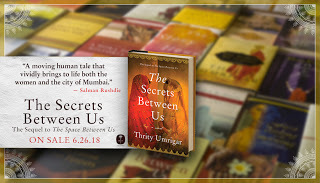
Before I knew and loved Thrity Umrigar, there were her novels. I reviewed The Space Between Us (which I adored), and she wrote to thank me, and we discovered we had so, so much in common and we became friends. (Of course, I cannot review her anymore now, it would be unethical, but I can interview her on my blog!) Not only is Thrity hilariously funny and an astonishing writer, she has a huge heart, a razor-sharp intellect, and a never-ending generous soul.
She's the author of Bombay Time, The Space Between Us, If Today Be Sweet, The Weight of Heaven, The World We Found and The Story Hour. She is also the author of the memoir, First Darling of the Morning. The Space Between Us was a finalist for the PEN/Beyond Margins award, while her memoir was a finalist for the Society of Midland Authors award. If Today Be Sweet was a Chautauqua Literary and Scientific Circle selection, while her other books have been Community Reads selections. Thrity is the winner of the Cleveland Arts Prize, a Lambda Literary award and the Seth Rosenberg prize. After earning a M.A. in journalism in the U.S., Thrity worked for several years as an award-winning reporter, columnist and magazine writer. She also earned a Ph.D. in English. In 1999, Thrity won a one-year Nieman Fellowship to Harvard University, which is given to mid-career journalists. While at Harvard, Thrity wrote her first novel, Bombay Time.
Thank you oceans and oceans for being here, Thrity.
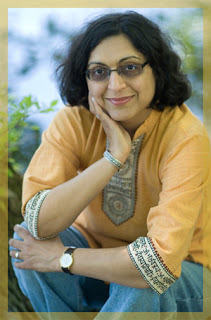 Portrait of the artist
Portrait of the artistI always think there is a why now moment for an author to write any book. What were the origins of this one for you?
I had gotten requests from readers for over ten years for a sequel but I always rebuffed those because I didn't really have anything new to say about the two main characters. But off and on, I'd find myself thinking about a very minor character, a vegetable seller who was a social outcast because of her bitter nature and because of a ugly-looking growth on her neck. Parvati earns a living selling six cauliflowers a day. How, I wondered, could she possibly earn a living doing this? And what life events have laid her so low to have brought her to this point.
And then, one day about two years ago, I knew the answer to those questions. I saw her backstory and as soon as I knew that, I was excited to "introduce" her to Bhima, from The Space Between Us, and tell the story of two distrusting, embittered, marginalized women who learn to trust and even love one another.
How difficult was it to write a sequel? What surprised you the most?
It wasn't difficult at all because it felt organic. If I had done what readers have asked me to do for ten years--simply continue the old story, it might have been hard going. But here was a book with not just one new character but three new characters, along with Bhima. And Bhima's story itself is so fresh because she realizes how foolish she's been to not take advantage of the new, globalized India. In many ways, it's the story of her inner journey from thinking of herself as a beast of burden to a full human being.
What surprised me most was Bhima's initial reactions to the lesbian couple she encounters. Despite being the victim of society's scorn, she herself is scornful of their relationship. I guess it taught me that victims are not automatically inclined to be sympathetic to other minorities, that for some, compassion has to be learned and developed.
So much of this gorgeous novel is about class and women, which makes it startlingly relevant to what is going on in America today. Could you talk about this please?
I think there are obvious differences in degrees between India and America when it comes to class and gender relations. But just today, I heard that while India is the worst place in the world for women, according to a new study, the U.S. is the tenth worst place! This feels inexcusable to me. India is a poor country, with mass poverty, illiteracy etc. But what is our excuse?
I don't think readers are going to use my novels to make an apples-to-apples comparison to conditions in the U.S. But my hope is that the softening of the heart that novels can induce, will make people more alert to the injustices in their own backyards or can feel a sense of solidarity with my characters that's egalitarian and without judgement. I don't want people to pity Bhima or Parvati. I want them to think, "Aha. I've had that thought or feeling, also. We're not that different, after all."
I cared deeply for all the characters and want to know how you develop your characters?
I just spend a lot of time with my characters. I go for walks with them, they accompany me into the shower. I wash dishes with them by my side. I hang out with them, carry out conversations with them. I never worry about plot. I'm just interested in their behavior and their values and am curious to see what they'll do next.
What’s obsessing you now and why?
Nothing much. Only the state of our democracy, the fate of the planet, climate change and who we will be as a people and a nation in five years time. Nothing much at all. But seriously, I'm equally obsessed with trying to figure out who I will become and who I am becoming. Will the current political climate result in a hardening of my heart toward those with whom I have such ideological differences? Or will I still be able to see their fears, their bruised hearts and recognize their humanity?
What question didn’t I ask that I should have?
Did I hear you say, "What are you working on now, Thrity?" Ah, I'll tell you: It's another novel set in India that deals in a graphic way with the treatment of women there.
Published on June 28, 2018 14:53



